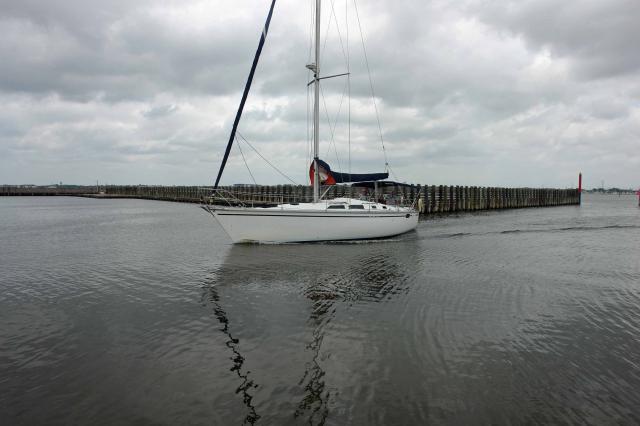
So let’s face it, across virtually all the sailing forums, Hunter is probably one of the most maligned brands of yacht there is…apart from McGregor, of course. “Cheap”, “Flimsy”, “Ugly”, etc. – you’ve heard it.
So why in the hell did I decide to fly in the face of all that “collective wisdom” and buy one? Simple, that sailing forum collective is just a bunch of yappin’ chuckleheads for the most part. They don’t know squat.
We started our sailing adventures on Mothers Day of 2008. I selfishly purchased a couple of weekends on a learning charter for Alicia’s Mothers Day present. Kind of like buying her a circular saw because you need one. But she loved it…and wanted more. We then lucked into a partnership on a Catalina 27 on Lake Travis through one of our acquaintances. $26/month was too amazing to turn down…especially when NONE of the other partners actually sailed the boat. We had full access to the boat, and took advantage of that sailing as often as we possibly could. It was the perfect boat and the perfect family activity.
But that started this curious addiction…spending stupid amounts of time on YachtWorld and various sailing forums looking for and talking about the “next boat”. The problem was, I had no idea what the next boat should be. This is where the yappin’ chuckleheads come in.
“Coastal” Versus “Blue Water”
When you, a newb, log on to a sailing forum and ask the question, “What kind of boat should I buy?” – you need to brace for the yappin’ – because the chuckleheads will absolutely bring it. The problem is there’s no way to really answer it unless you provide a good deal more detail on your needs. Now, many people on the forums will tell you this and try to help you think it through a bit more. And this is good. So let me give you a bit of advice if you’re gearing up for this question…have the following few details pretty well nailed down:
1. What is your budget?
–No, your REAL budget. What is the top amount you’re actually willing to commit to for the purchase AND for the work thereafter to start your sailing. Set it in stone.
2. What is your intended use for the boat?
–Inland sailing (lakes, etc.)
–Coastal sailing/island hopping
–Blue water passages (crossing oceans)
–High-latitude voyaging (Northwest Passage or Cape Horn)
3. What size of boat do you want?
4. What is the oldest boat you’ll consider?
5. How many will typically be sailing the boat and what is the level of experience and physical ability?
6. What kind of performance do you want out of the boat (if you care)?
7. What features are you looking for?
There are many more questions you’ll need to answer down the line, but this is a good start. But, here’s the deal, even if you have specific answers to every one of these questions, you’ll STILL have a crap-ton of decisions to make as you wade through all the yappin’. One of the most common of these is…do you go with a “coastal” boat or a “bluewater” boat?
“But wait,” you say “I just said that my type of sailing will be coastal or island hopping, not passages. I HAVE the answer for this!” Cue the chuckleheads.
See, in the “which is better” debates on the forums, “coastal” or “bluewater” doesn’t just refer to the activity of the boat – it refers to the “build quality”. Put quite simply, the “blue water” boat is “stronger and heavier” than the “coastal” boat. Why all the quotation marks? Because all of this is extremely relative.
The default mode for most chuckleheads is that “heavier is better” and/or “heavier is safer”. In other words, even if all you’re going to do is bay or coastal sailing, why not have a “strongly built bluewater” boat? Their logic is that you’ll be able to weather squalls better, the boat will last longer, it will be more “seakindly”, etc. Sure, for most people’s budget, this logic basically means that the only “safe” boats were built 40-50 years ago – but let’s not complicate things.
When you’re brand new to the game, this all seems pretty hard to argue with. I mean, who doesn’t want a “better/safer” boat? As a newb in the market for your first real boat, just thinking something different seems like pure idiocy. I believed it at first, and paid very close attention to the examples they offered up…boats like the Valiant, Pacific Seacraft, Pearson, Passport, Tayana, Bristol, Hinckley, Shannon, etc. It’s a very long list…mostly dominated by my friend Bob Perry’s designs (and rightly so).
These boats are inarguably, the real deal. They can take you anywhere. Period.
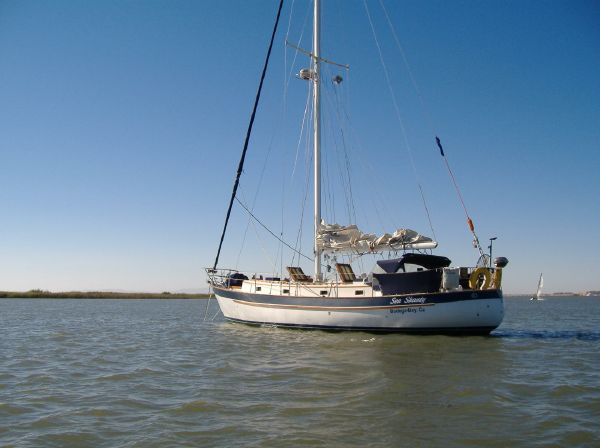
The Valiant 40
So, with those brands in mind, it was time to start looking for boats. Based on that list above, here were my priorities when I began:
1. What is your budget?
–$50K or less (with a 10% upgrade/repair budget). I could have spent much more, of course, but I wanted to buy with cash and relax in the freedom outright ownership provides.
2. What is your intended use for the boat?
–Coastal sailing/island hopping (U.S., Mexico, Caribbean)
3. What size of boat do you want?
–36′ to 45′
4. What is the oldest boat you’ll consider?
–1980
5. How many will typically be sailing the boat and what is the level of experience and physical ability?
–2-4 people in good shape, new sailors but with some experience
6. What kind of performance do you want out of the boat (if you care)?
–Good performance yet tough boat. I did NOT want a full-keel pig.
7. What features are you looking for?
–Roomy cabins, centerline berths (“like a real yacht”)
–Sloop or cutter (not a ketch or yawl)
–Aft cockpit
With this list in front of me I happily typed in that URL that is every dreaming sailor’s productivity killer: Yachtworld.com. To give you an idea of how the typical workday YachtWorld sabbatical went for me, this was my search:
Look at the top of the page and click on the “Manufacturer” list and click on “more…” Here is the list of manufacturers I needed to start making sense of…a list likely close to 100 different possibilities. Again, as a newb boat buyer who knows very little about boat brands – how do you do that?
The first thing you’ll notice is the conspicuous absence of most of the great brands listed above. Sure, I would see one or two such as a Tayana or Passport – but they typically were basket cases. It was clear most of these top bluewater brands were way out of my league (a testament to their designers). So immediately I realized I’d have to narrow my horizon. I obviously wasn’t buying a sail-ready Hinckley or Valiant with my budget.
So, I started focusing on the newb’s boat buyer equation: “Okay, what’s the longest, biggest boat I can possibly afford?”
I quickly discounted Lancers, Yorktowns, Bruce Roberts, and the like based on their forum reputations. However, there were two boats I liked that were close to my specs and typically held in some level of “bluewater esteem” by the yappers. Those were the Gulfstar and the Morgan Nelson-Marek.
The Gulfstar had a reputation as a freakin’ tank. It was built very heavily for the charter trades so it wasn’t a fast boat by any means. The ones in my price range typically needed some work, but it was a lot of boat for the money – and it had the “yachty” features I wanted:
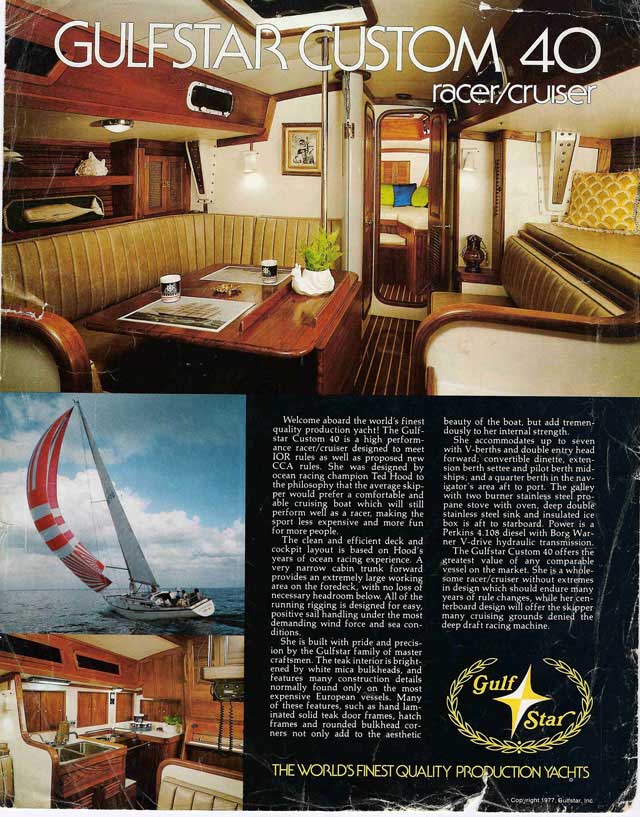
The snail planter is a great metaphor for the performance of the Gulfstar.
And I especially liked the center cockpit version that provided a very pimpin’ aft cabin with centerline berth:
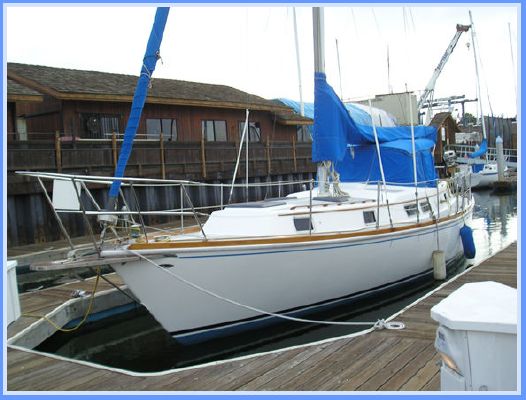
The 43′ Center Cockpit
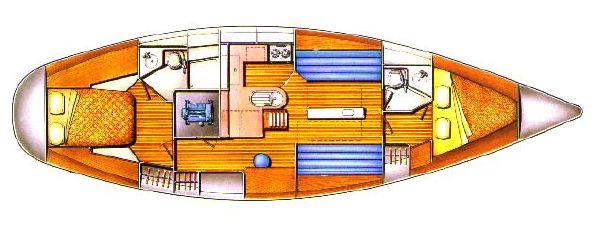
The 43′ Layout
Then there was the Morgan Nelson-Marek 454. This boat provided the really nice accommodations I wanted – but it was also fast. It was pure sexy as far as I was concerned.
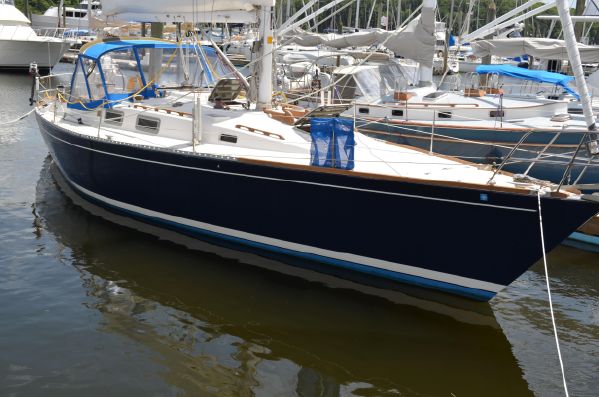
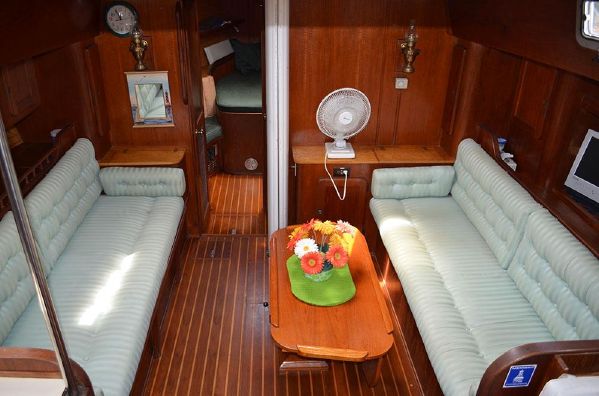
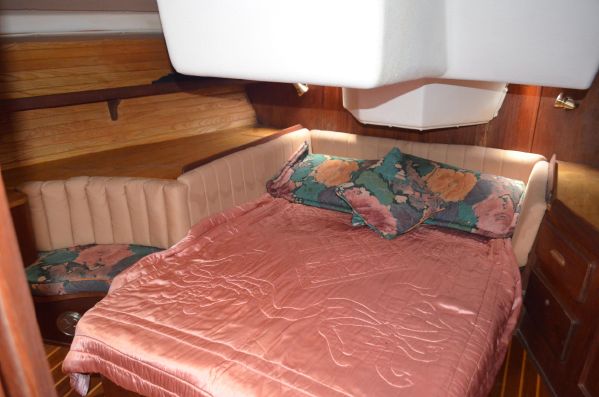
Ack. Not diggin’ the pink satin – but you get the point.
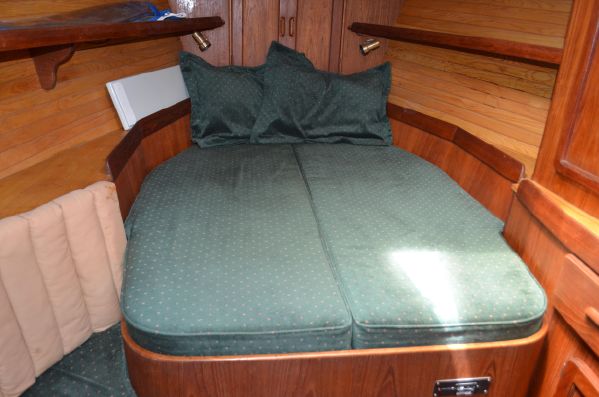
I loved this boat. It was definitely my dream boat. One of the unique things I loved most about it was that it had a roomy aft cabin with full centerline berth…EVEN WITH an aft cockpit. Overall, the 454 was my idea of perfection.
The problem was that the N/M 454 was typically out of my price range. When one did turn up in range, it needed substantial work. And I was at least smart enough to know that a boat that big requires a big repair/upgrade budget after the purchase. And I wanted to sail – not work on boats. Furthermore, 45′ is a hell of a lot of boat. Way more than I was ready for. So I just continued to dream.
I also saw a few Gulfstars here and there that were serviceable within my price range – and even a couple that looked to be incredible deals – but I just wasn’t ready to buy at that point. And, anyway, I didn’t love the GS like I did the N/M.
Now, remember, these two boats were just the two that felt right to me. Beyond these, I looked at every model in my range – Cheoy Lee, Endeavor, Morgan, Tartan, Pearson, etc. You name it. ALL the “bluewater” brands that were in my ballpark.
But as I did this, trying to stay true to the “bluewater” mantra, something kept catching my eye. There were TONS of “production boats” (Beneteau, Hunter, Catalina, O’Day, Irwin, etc.) that could be had for far less for far newer and far better equipped. It made me start wondering if this “bluewater” hysteria really made sense for someone who planned to cruise like 98% of the other cruisers out there…that is, not planning to cross oceans. Why did I really need “heavier” to deal with the fearful conditions of the North Sea the yappers always put forth, when I had absolutely no intention of sailing the North Sea?
So I started a thread on Sailnet to ask about this very thing:
Production Boats And The Limits
And although there were a few typical yappers, I found that Sailnet generally provides far less yapping and far more solid information than most forums. It was indeed a very enlightening discussion with great points all round by many sailors with many different boats – and even a couple of nautical architects.
I also read a fantastic book at this time by Hal Roth entitled, “Handling Storms at Sea”. Apart from the valuable advice on how to actually deal with the kinds of storms the yappers always refer to when illustrating the need for “a heavily built boat that can withstand anything” – there was this quote that truly put things in perspective for me:
“During the past 40 years I’ve sailed some 200,000 miles on the world’s oceans either by myself or with my wife. Yet in all these seagoing passages – some up to 52 days in length – I’ve never seen prolonged winds of hurricane strength and only one violent storm of Force 11. My point…is that violent weather is infrequent and that with care in planning bad days can be avoided or certainly minimized.”
In this forum discussion and this book, I began to realize something: The level of forum-based fear driving the advice to get a heavy, bluewater boat in order to increase your chances in a storm far outweighed the reality. The storm conditions so often quoted on forums to justify this bluewater-boat-only-advice are exceedingly rare. And with good planning, especially in the context of general coastal and off-shore sailing (i.e. – not long passages), you really should be able to completely avoid dangerous weather. I mean, who are you going to believe? A bunch of yapping chuckleheads? Or Hal Roth?
So, for me, the question came down to this…if the chances of storm conditions used to justify buying a bluewater boat “just to be safe” are, perhaps, 1% – that means you will spend virtually ALL of your cruising life in a boat that is far slower and heavier than you really need…especially if you’re a coastal sailor or island hopper.
To clarify the points underlying this debate, here is the typical break down of why a “bluewater” boat is better at sea than a “more ‘modern’ production boat”:
1. The “comfort” of the boat in seas.
–This seems to typically come down to the hull design (deep, heavy and slow versus flat, light and fast).
2. The stoutness of the boat in a storm.
3. The tankage, stowage, and layout of the boat.
In my forum discussions in the above Sailnet thread and my research, including Roth’s book – I was definitely questioning the conclusions drawn about #2. The fearmongering and resulting “bluewater” advice was WAY overblown. In fact, I made the following comment in the thread:
“I’ve always believed that most of us on the forums have so little true ocean time, that we harbor the ‘there be dragons’ mentality toward off-shore sailing, when it’s actually (statistically speaking) more deadly sailing around in a lake or bay.”
I still believe that to be true, regardless of the brand of boat you choose.
But, let’s look at the other two items, starting with #1) Comfort in a seaway. There are hundreds of pages of debates on this issue in any sailing forum you go to. In the thread above, you’ll find a pretty good discussion on this, along with links to other threads going into much more detail. Now, I’m certainly no yacht designer so I won’t go into detail here. You can look up guys like Jeff_H, PCP, and BobPerry on Sailnet for their much more accurate explanations. But let me take a shot at generally explaining the basic issues.
In essence, the debate centers on the idea that the traditional heavier, deeper hull and longer keel configurations are more “comfortable in a seaway”. This typically means that they can heave-to more easily and are more “stable” (i.e. – can “cut through” the waves) especially when beating to windward. This is compared, they say, to the more modern faster, flatter hulls and fin keel configurations which have a tendency to “pound” into/off the waves when beating to windward. Now there’s no arguing that pounding is uncomfortable. That’s the kind of motion that encourages projectile puking all over your cushions. The other very valid safety concern here is that beating into large violent waves for hours or days CAN INDEED tear a boat up. There’s no denying this.
But, again, the issue is…you don’t HAVE to beat to windward when conditions are really bad. As Hal Roth says, just heave-to or, better yet, hang out with a drogue. And we’ve already established that conditions are very rarely that bad. So, yet again, the percentage of this particular occurrence, especially for a coastal sailor, is going to be extremely low. Add to this argument the very real issue of a more modern, faster boat being more able to “outrun” bad weather than a heavy bluewater boat in the first place, and things start getting thin on the “bluewater’s best” side of the argument.
So the main reason you’d be buying a heavy bluewater boat to cruise the coast or island hop is to be prepared for some storm that has a fraction of a percentage chance catching you – AND into which you have to beat? THAT’S what you’re buying your boat for? That didn’t make sense to me. It’s like flying to the Bahamas and spending your entire vacation in an inland storm bunker because there is a minuscule chance a hurricane could come through. Who does that?
Finally came item #3) Tankage, Stowage, and Layout. I’ve already discussed the features I was looking for in my own boat – and some of these like the centerline berths, etc. were decidedly “non-seaman-like” in many an old salt’s eyes. But, based on the sailing I was going to do, I didn’t fully buy into the arguments that every single berth needed to be lee-cloth ready (this became much more obvious when I began to do ocean races…see below). Tankage was important. I wanted plenty of fuel and water – but since I’d pretty much always be a few hundred miles from access to these, I didn’t need to over-do it. These things were just not as big a deal to me as they would have been to a passage making sailor who would need to be fully stocked for weeks- or months-long-passages.
All that said, there were some “seaman-like” layout features that yappers would typically point out that I fully believed in. For example, I wanted nice, roomy side decks for safety in working forward in a seaway. I didn’t want a huge, deep cockpit or an oversized companion-way hatch to protect against possible down-flooding from boarding waves. A drogue will be my primary heavy weather tactic, so this was definitely something to consider. I also wanted all lines run back to the cockpit to make things easier and safer on us. To me these were all good ideas.
So things were coming more into focus…and bluewater boats were becoming less and less important in my purchase equation. Production boats started to look a bit more interesting – though I was still gravitating to the premium production boats like Tartan, C&C, Sabre, etc.
Then I started doing ocean races. I raced on two very nicely maintained, quintessential “bluewater” boats…
A Pacific Seacraft/Crealock 37 Cutter…
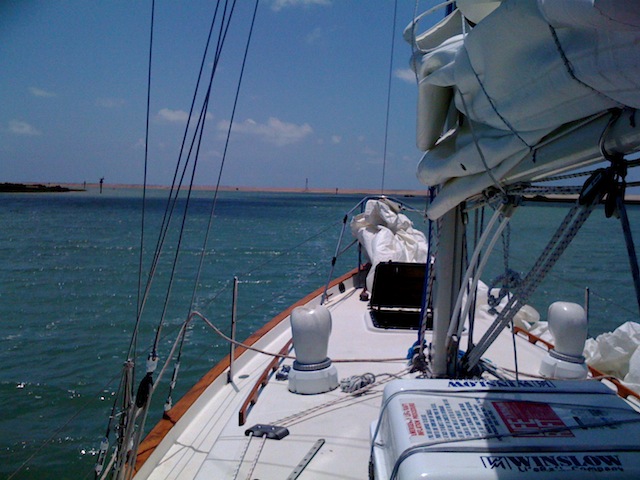
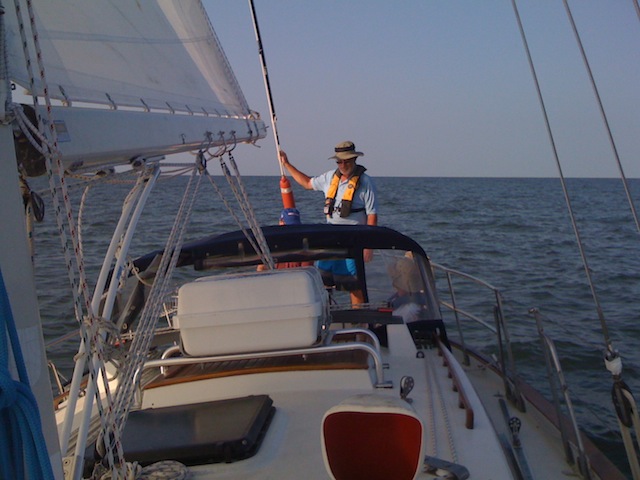
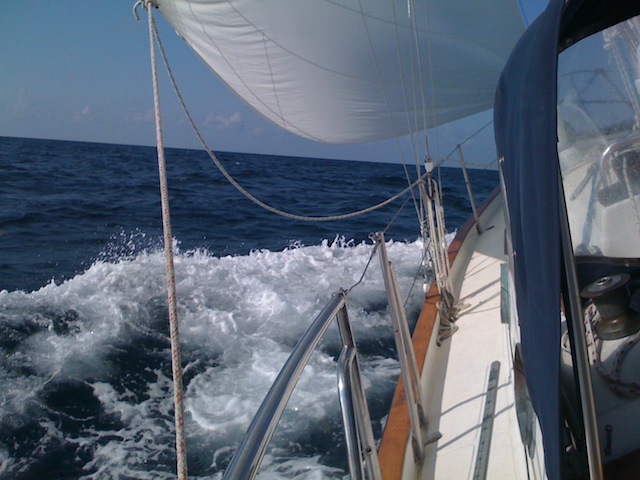
And a Pearson 365 Ketch…
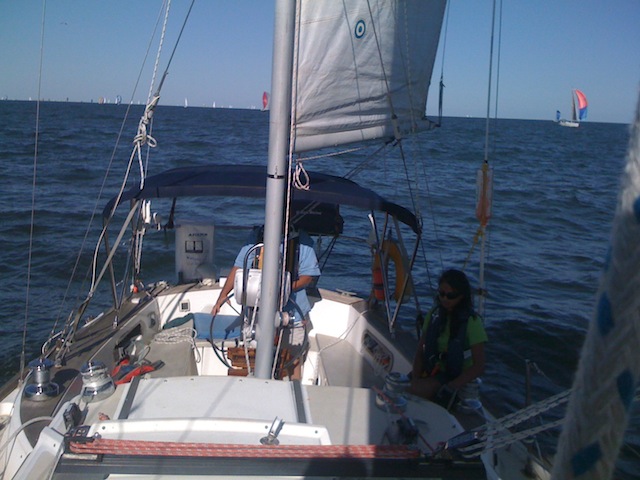
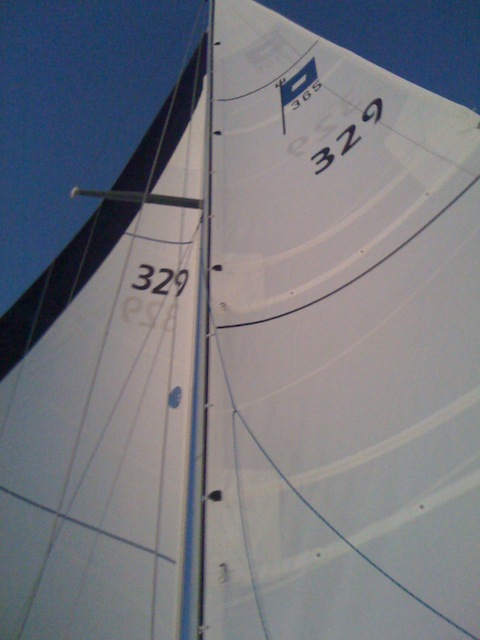
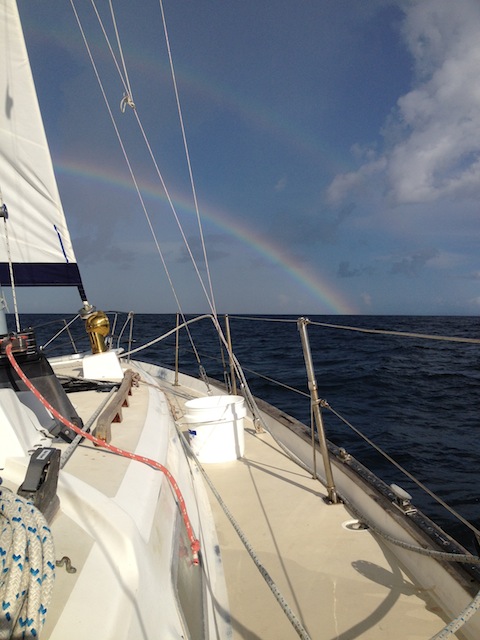
Between these two boats, I sailed over 1,200 miles in the races and returns. The worst conditions we ever faced was Force 7. And it was clear that these boats are extremely solid – even though both had the typical annoyances of older boats such as head doors that wouldn’t quite close, creaks and groans underway, etc. They were easy to sail and could clearly undertake a circumnavigation – which the Pacific Seacraft eventually did.
As for the “seamanly” accommodations below, I could see that the “lee-cloth’d seaberth throughout the boat” argument (e.g. – no centerline berths) was pretty weak. We typically had a crew of 6 – and between the v-berth and the salon seats (rigged with lee-cloths), there were plenty of secure seaberths as we rotated on and off watches.
Also, to be honest, I actually found these boats a little tight down below for my taste. Great for 3, crowded with 6. More importantly to me, they were relatively slow. Granted, they were not designed to be racing boats. But though we won our cruising division in various races on both boats – it was seriously painful to be dialed in at 7 knots, then watch a parade of Beneteaus, Hunters and Catalinas sail right by us.
These boats represent some of the best, most revered, bluewater cruising boats around. And I certainly have no business or desire to take anything away from them. I just realized, they weren’t for me.
BeneJeneHunterLina
So I’d now come around to the idea that production boats were not the flimsy deathtraps the yappers typically presented them to be. When is the last time you read or heard of a production boat being completely demolished offshore in a storm? Damaged – probably. Severely – maybe. Demolished – no.
I had also narrowed my boat size requirements quite a bit after the races to between 38′ and 40′. This seemed to be the sweet-spot for us in terms of room and manageability.
My search moved to the higher-end light-blue-water boats like C&C, Ericson, and Sabre, and the leading production boat brands, Beneteau, Jeanneau, Hunter, Catalina, etc. – mockingly referred to as “BeneHunterLinas” by the chuckleheads.
Now, after owning a C27, I had to agree with them somewhat. Though Childress did it after some beefing up, I would NOT have taken my C27 across oceans. No way. It was obviously a lightly-built weekender/coastal boat. I might have taken it on the same off-shore race trips we’d done in the same conditions – but nothing bigger than that. So I was still a bit cautious in wanting a more heavily built (e.g. – full glass, non-cored hull) boat.
The problem for me was that I was still dreaming about that Nelson/Marek 45. The layout of those full-blown cabins and roomy salon was perfect as far as I was concerned. I didn’t like the split aft cabins or, worse, half cabin-half head layouts I was seeing in virtually all the boats I was coming across on YachtWorld. And I definitely did not like the open quarter berth set-up. Just not my thing.
That magical N/M combination I was looking for knocked out most of the “premium brand” light-blue-water boats and the raft of Catalina 38s continually popping up in my price range. The Catalina 36 had a layout close to what I wanted, but it was too small. Then there was the Hunter Cherubini 37 that the “blue water” chuckleheads had at least some amount of respect for. But I just couldn’t get excited about it.
On the other hand, Beneteau had some interesting possibilities. The Idylle was a pretty well regarded “blue water capable” boat. But it looked a bit frumpy to my eye. Kind of like white nurse’s shoes. Just not a lot of sexy. On the other hand the First series seemed like an absolute no-brainer in terms of what I wanted…very fast and tough. There are numerous stories of Firsts circumnavigating, blasting through horrible conditions in the Southern Ocean to win races, you name it. Bene Firsts are, without question, great boats.
So I looked at several in my price range…from 38s to 42s. But as much as I wanted to, I just couldn’t get excited about them. Though they were, without question, thoroughbreds, there were two serious turn-offs for me.:
1. The damn headliner! EVERY single Bene I looked at had a seriously hot mess for a headliner. They were all saggier than a 70-year-old stripper. Who wants to put money into fixing that? Freakin’ nightmare.
2. Primary color sinks. Seriously? Who does that? This is a yacht! Not a day care center!
I know…it sounds silly when you’re considering a yacht…but it’s not really. You have to love what you buy. And though I KNOW I would have loved sailing a Bene First…I also had to live with it.
Here is a very well-kept First 375 that I came >THIS< close to buying:
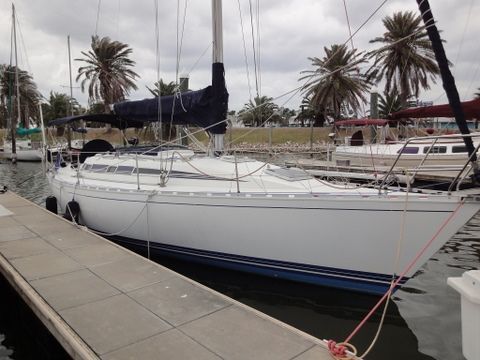
Gorgeous and immaculate on the outside. She oozes fast.
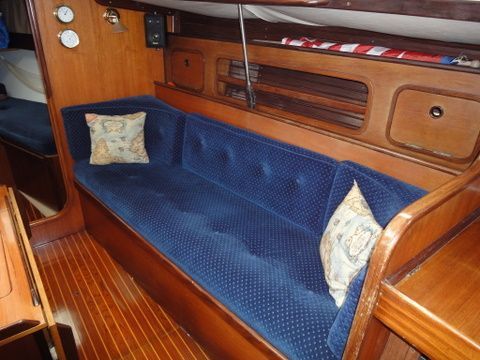
But here we have the Granny Panty headliner.
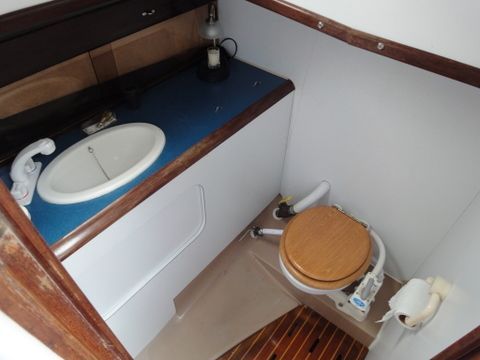
And the Romper Room head.
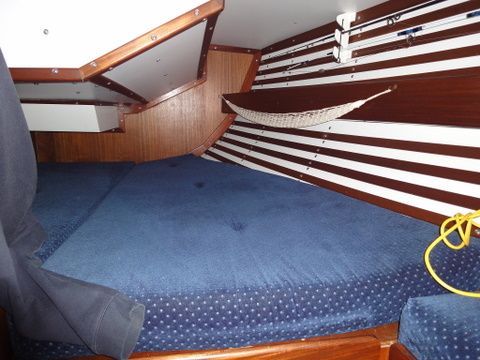
And finally the coffinesque aft “cabin”.
Again – nothing wrong with this particular boat at all, in fact it was just about perfect compared to others in the market and at a great price to boot. I just personally couldn’t do it. And that’s actually saying something. The Beneteau First is a very well respected boat by all the yappers who hold fast to the bluewater mantra. It’s kind of the perfect cross-over between a racer and a cruiser. And as much I hate to admit it, the thought of being able to brag about having that “perfect” boat was very tempting. Who could possibly hassle me for buying a First 38? No one.
But there was another boat that kept coming up in the searches – and calling to me. It was the mid-to-late-80’s Hunter 40. As for the look and feel of this boat, it doesn’t take a rocket surgeon to see why it appealed to me:
The N/M 454:
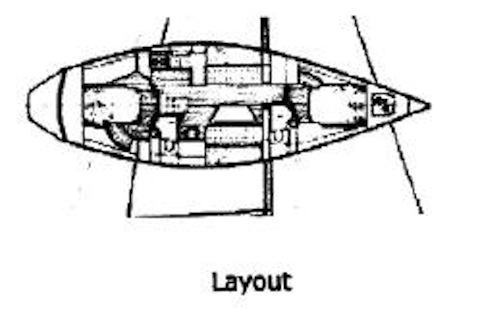
The 454 layout.
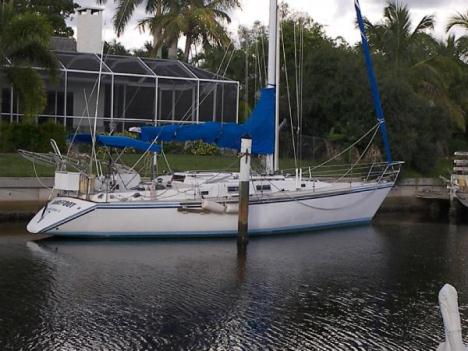
The 454 profile.
Our 1989 Hunter 40

The H40 profile.
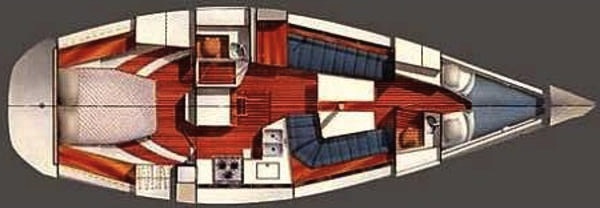
The H40 layout.
See the similarities?
It had virtually EVERYTHING I was looking for. Spacious layout, no sagging headliners, a VERY respectable NE-PHRF of 96, and great off-shore design features on deck (great cockpit, minimal companionway hatch, nice side-decks)…but…
…it was a Hunter.
With all the yapping on all the forums about how crappy Hunters are in terms of build strength – how I could I possibly go on a forum again and say I chose a Hunter 40 over a Beneteau First 38? This was blasphemy!
Then came two very interesting pieces of information that made me understand this strange anti-Hunter hysteria of the forums was completely ridiculous.
The Facts and S/V Sequitur
Many of the things the forum yappers have decried about Hunter designs and build-quality were things like “the arch” (moving the traveller onto an overhead arch to get it out of the way), or a rig with no back-stay, etc. Yet, within a few years of Hunter’s introduction of these “ridiculous and dangerous ideas” – several other higher end yacht designers and builders picked them up as well. The yappers tended to be quiet about this as it turned out many of those “ridiculous and dangerous ideas” were actually great innovations. They were clearly wrong. So, as I’ve said above, I’d already blown off most of their blather.
To me it was purely about this…how tough is the Hunter 40 really? Could it handle a Force 7 off-shore blow, Force 8, 9? Would it just fall apart in the waves due to poor build quality like the yappers implied?
The first real evidence of the collective idiocy came in an interview between Sailnet’s own Jeff Halpern and Jim Bohart of Hunter Marine. The interview, conducted in 1999 can be read here:
Interview of Hunter’s Jim Bohart
I encourage you to read through the entire interview. It’s great. But here’s the takeaway – Hunters are built to be bluewater boats.
AAAAAAACCCKKKKKK!
Now, I promise, 90% of the forum yappers out there STILL refuse to believe this. Hunters are bluewater boats? Never!
And here’s why they are all wrong. How do you think a Hunter would fare in an F10/11 Southern Ocean storm off Cape Horn?
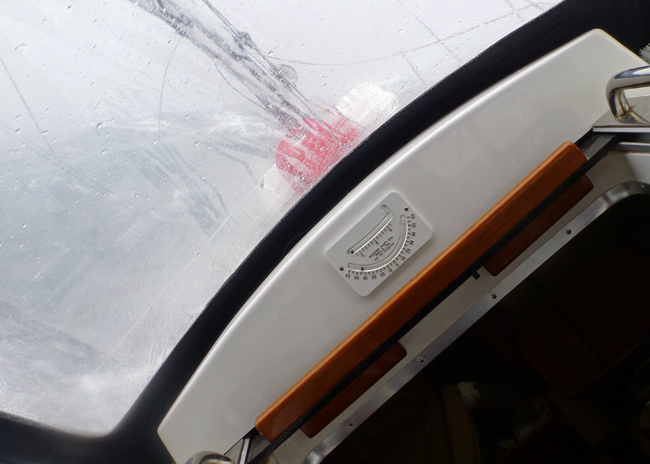
S/V Sequitur, a Hunter 49, off Cape Horn in 52+ knots.
The answer is…just fine. But, I’ll let Michael tell you…
“I set-up a plot on the iPad to track our drift, and we laid down on the main salon couches to relax and watch the storm happen.
The port sidelight in the salon was looking bottom-ward a few times as breakers hit our starboard beam. Overhead, through the skylights and hatches we watched as great depths of green water sluiced over the decks. We remained dressed, with boots on and covered ourselves with duvets and napped.”
Now how is it possible that a Hunter 49 sailed around Cape Horn in F10/11 conditions? Isn’t this the absolute definition in every possible way of “bluewater”? Shouldn’t a flimsy Hunter have been ripped to pieces?
The answer is simple – Hunters are built the way Jim Bohart says they’re built. They can take it.
So, here was my conclusion in the Production Boats thread:
“Okay – so – after studying and discussing this issue for over 4 years now, I have reached a conclusion…
There are virtually no limits on any production cruising boat. You can sail most any boat around the world…as long as the weather is right, and as long as you are a pretty good, pretty conservative sailor.
The whole “bluewater boat” debate is crap. We can go ahead and lock this thread now.”
And here was my conclusion on my purchase…I went out and bought a 1989 Hunter Legend 40.
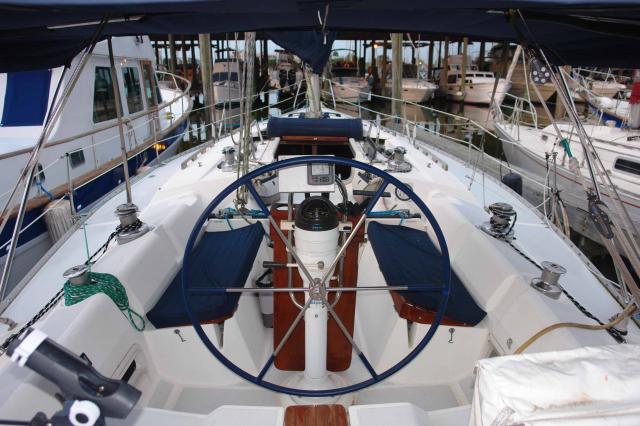
And I’m not a bit scared.

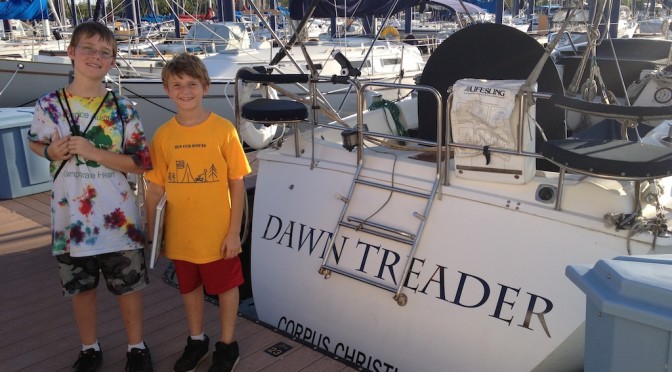
Lol yeah I think all the old timers are just to stuck in there ways 33ft hunter is my choice see ya later boys im gone.
Hey Matt – it’s been a long while since I’ve been on this blog. But I appreciate your comment. And remember, chuckleheads will be chuckleheads.
I am buying a 2000 Hunter 410. This is a great article. We are going to take “fortuna” from the Chesapeake to the Carribean in comfort and style. The chuckle heads can just pound sand lol
Hey Andrew – it’s been a long while since I’ve been on this blog. But I appreciate your comment. Chucklheads do, indeed, pound sand.
Thank you for the article. As for build quality being questioned, I find it hard to fathom since everything on my 1993, 37.5 legend works! The Boat was obviously maintained well, but every door, hatch, etc still works perfectly. 1993 houses on land have doors that sag on hinges. Not this boat!
Hey Bryan – it’s been a long while since I’ve been on this blog. But I appreciate your comment. Good learning for others. Just more evidence that Hunters do, indeed, rock.
I bought a Hunter legend 35.5 on Long Island and sailed it back to Albemarle Sound., NC. Since we would be sailing in the ocean part of the trip my fellow passengers wanted a Licensed Captain to go at least the part from Long Island to Cape May and we continued on to Annapolis, MD to drop off the Captain.
I bought a tides and current book and happily announced that we would have an incoming current of 1.7 knots which would help us up the Delaware River. That was true but when we got to Cape May the current was as predicted but what was not predicted was the wind was coming down the river at around 25 to 30 knots. This made for a very flaming ride up the Delaware with waves coming over the bow. We were slamming very hard fighting into the wind.
When we got to the C & D canal into calmer water the Captain said “I would take this boat anywhere”. Enough Said.
I love my Hunter Legend 35.5
Patrick from Albemarle Sound.
Hey Patrick – it’s been a long while since I’ve been on this blog. But I appreciate your comment. Good learning for others. Hunters rock. ‘Nuff said.
Another late reply to this excellent write up. I learned so much.
I’m just learning how to sail and don’t yet have a boat myself but have spent many hours pouring over boattrader and yachtworld and walking the docks at my yacht club pining after one gorgeous boat after another.
I wasn’t aware of the ‘reputation’ Hunter had amongst forum dwellers. Funny thing is that from the start I’ve been drawn to Hunters. For any given size I just love their below deck layouts compared to other boats. Your thoughts on Hunter definitely resonate for me.
I would eventually love to get into a 40-45 Hunter. Though for a first boat I worry that might be too much. I think there is still a lot to love in the Hunters that are around 30-35 feet and the price point on those from the late ‘80s or early ‘90s seems more accessible for a newbie who is just starting out while still allowing for reasonably comfortable Great Lakes cruising for a family of 3.
Thanks for writing this! It was one of the most useful sailing articles I’ve read.
Thanks for the note Adam. I’m glad the article was helpful. And, yes, I STILL recommend Hunters. They are great boats. Period. As for the size, I went from a 27 to the 40 – and it felt freakin’ huge. But you get used to it. Just go slow around the hard bits and have the buffer handy!
I’ve come across a 44ds that is interesting.
7’ headroom being one of the highlights.
I’m a 6’6” sailor, and stooping the whole time is not as glamorous as it sounds.
I’ve only found warning bells in the forums so to have come across your blog is a breathe of fresh air.
I’ve been sailing for years and own a 32’ yacht. I single hand easily most of the time.
How much of a dramatic step up is managing such a big vessel?
It has a thruster.
Thanks so much for taking the time for putting this all together.
Cheers
Bruce
Hi Bruce. I’m glad you enjoyed the article. As for the size difference, I went from 27 to 40. It sounds like you’d be doing about the same jump. It does feel like an aircraft carrier your first few times in and out of the slip. But like all things you get used to it pretty quick. Of course, all that extra room below is pretty damn nice! A thruster will make a world of difference. You should be able to put that thing exactly where you want her.
Well written article.
I took the plunge last January and purchased a 1999 Hunter Passage 450. Right now, all I have done with her is sail in Lake Ontario but, have larger plans as soon as I can leave the rat race.
So far it has been a dream sailing and be aware. I never sailed until I bought this boat and people said, “that’s a lot of boat for your first”. She has been a very forgiving boat so far. I’ve managed to single hand her already and with little effort. She’s taught me a few lessons so far on not to get too cocky but overall, I love her and I am quite confident that she will be a great live aboard for my wife and I.
I too read all the bad press Hunters were getting but, couldn’t draw myself away from it’s creature comforts and after being on the sea trial and seeing she performs well heeled way over I knew I had a boat I could feel safe in.
If a boat can make a newby sailor look like he knows what he is doing, it has to be built to be handled easily.
I have no regrets on my purchase and as far as I’m concerned, you get a lot of bang for your buck as well as a lot of compliments on how nice a boat she is.
I’m really glad I stumbled across your article to see that Others feel the same as I do about Hunters.
And by the way, in my first year, I’ve had the pleasure of running aground, luckily not so bad that I wasn’t able to back myself back off, been caught in storm conditions with 50 knot winds catching me broadside. With the sails rolled in and engine power, and a few terrifying thoughts running through my mind while we’re still heeling at 8 degrees, she got us through it and safely back to the marina. She is a very sturdy boat and in spite of all that is said about not being very good at downwind sailing or upwind, I manage to do pretty good at beating into the wind and with a good sized jib she moves along quite well downwind as well.
It’s a shame that Hunter is no longer because, they kept the big boys on their toes with all of their innovations. Just my opinion.
Thanks for the enjoyable read.
Thanks for the note Bill. I think you’ve summed things up perfectly. Enjoy that Hunter!
Thank you for your highly entertaining article that mirrors my search for my first boat. I read all the the reviews that indicated the need for a custom built armored sailing tank or YOU’RE GONNA DIE!!! My needs require, an easily handled by a new solo sailor. Coastal cruising, no ocean crossings for me. I am leaning toward a Hunter 320. Thank you again.
Hi Kimberly – glad you got something out of the article. An H320 packs A LOT into 32′. Though a bit older model, don’t overlook the 37 Legends. As you saw, ours was the 40 Legend. The 37 has a smaller cockpit than the 32, but it’s got that nice aft cabin and full bed. Anyway, enjoy your search and your boat. And let me know where you end up! Cheers!
Thank you for you wonderful well written article. It alone shows great intellect and thought. After much study I concluded the same and have a 2005 Hunter 456 under contract. I plan on upgrading the boat, living in it and cruising. Thank you so much for the article.
I’m glad it was helpful FD. Cheers.
Thanks for you very informative article. The way you told your story about your search reminded me of my own search. After mounts of searching I finally ended up with a Hunter 335, year ‘92, but in excellent condition. It is, by no means, a project boat. We love it. We both like the cabin lay-out. For some strange reason I was always leaning towards a Hunter. I looked at Beneteaus, Catalinas, Tartans, O’Days, but none could excite me as much as the Hunters. So, now we are the proud owners of a beautiful Hunter335. Perfect size for our needs, which is sailing the Chesapeake Bay and coastal waters.
Thanks for the note Alex. I’m glad the article was helpful – but more importantly, I’m glad you got the boat you love. Enjoy her!
Hi – I know this is maybe late in coming and you’ve seen the same things written over and over…but a comment and couple of questions. I lived on board with my wife for 10 years on a 41ft William Garden full keel clipper ketch (technically a Trans World 41 but the same molds I assume as the CT 41 and others)…in short a full keel 30,000lb chunk of fiberglass. I LOVED THAT BOAT! Not least of all because kids thought it looked like a pirate ship. But if you didn’t have 10-12kn she just wouldn’t move. Now in hard blows she was great. Did a lot of offshore stuff to Philippines etc and in some heavy stuff (45-50kn and 20-25ft seas) and that was where she proved to be so solid but as you’ve said in over 10,000 miles of blue water there were maybe 400 done in adverse conditions. Which I am assuming a Hunter could have done just as well I guess?? I live in Annapolis and looking at the next boat and have looked and sailed on all the usual suspects. Did you ever have issues with the holding tank not really being a tank and glassed in under the aft berth (that’s my understanding) and how did you get on with the heat/stuffiness in the aft cabin? Others have whinged about the high freeboard…thoughts? I admit I don’t like the traveler on an arch and also lines running under covers back into cockpit…access is my concern. But going to be on the Bay mostly and trying to get rid of the “I want to cross the Atlantic” urge and settle down…but if I did decide to cross the pond…would I make it? Thanks for the very honest article…loved it!!
Hi Floyd – thanks for the great story and comments. From what I’ve seen, CE-rated Hunters are definitely built to their rating. The heavy conditions you describe, assuming they are sustained, are F9. The larger Cat-A Hunters are built for that. So, yeah, I see no problem (though I certainly wouldn’t want to be in that too long). You can see some more of this reasoning in my blog post HERE. As for the holding tank ’89 (our model) and newer moved to traditional holding tanks. The aft head tank was below the aft cabin closet. So we never had a problem like with the earlier models. To that point, I would personally stick with a ’90’s to mid-2000’s model. I loved the aft cabin. there were a total of 5 opening ports (3 around the cockpit and 1 on each side above the closets). Plenty of flow – and with the fans, not stuffy at all (except at anchor in Louisiana in July). And finally, yes, our boat could have crossed the pond. No question.
This is a great article, and still very relevant in 2020. Thank you for taking the time to write it!
I currently own a MacGregor 26s (not a real sailboat) that I tow behind a Honda Ridgeline (not a real truck), and I realized when buying my Mac that “haters gonna hate.” The Mac sails just fine and we love it (moving between lakes in the mountains) and the Ridgeline tows it like a dream (5K towing capacity for my “fake truck”). I also realized that for all the hate online for Macgregor/Ridgelines, in real life it doesn’t happen. Anyone who sees my truck loves it, and anyone who sees our Mac seems to enjoy looking at it. I’ve had two people make comments that weren’t flattering, and both of them were douches that weren’t worth knowing, anyway.
And here’s the kicker.. Both my truck and boat have very active, very friendly, very helpful, and very large owner groups! I don’t need to ask the chuckle heads for any advice at all, because someone with hands on experience is always available to show what they did, with pictures, and step by step instructions.
Buy a specialty boat with only 300 ever made and your support group will be either a small surviving group, or the chuckleheads who will still look for fault in your boat at every turn.
Or buy a production boat (for all the reasons you lay our in this wonderful write up) and you’ll likely be welcomed into a wonderful family of folks who see through the blather like you did.
I’m looking to step up now only because I’m ready for some head room on the boat, and more entertaining space than my Mac allows. I may still keep the Mac on the trailer in the yard, because it’s hard to part with a 26ft sailboat with a queen aft berth that sails well in light-medium wind that I can get on/off the trailer in just over an hour and that I can take to new waters whenever the fancy strikes me, even if it’s not a “real boat.” 😉
Thanks for the note GW. The Macs do what they do very well. No hate here. Once you get away from the computer and out on the water, the production boat bashing goes away. Meaning…Chuckleheads don’t sail.
Thank you for your analysis, I’ve come across and read your article and reading comments more than once. I always wondered about Hunter, but especially the knuckle heads comments on this brand. They are dismissed, I cannot stand any armchair sailor or armchair anything.
So Hunter still has a fair chance with me along with Canadian Sailcraft 36T or Merlin, Islander Freeport 36, Bene Idylle 1150, Hunter 356 and the likes and S2 11 C.
Been studying sailboats for the past 2-3 years working hard on my “dream”, preparing saving, educating/certifications and gathering experience as a sailor. Caribbeans will be the destination and getting there through the ICW. That’s my dream in about 5 years.
Thank you for you insight and all of those who commented! It makes for real info from real people.
Carl B
Montreal, Canada
Carl – thanks for the note. And I’m glad you found the article useful. There have been LOTS of great comments too. It’s cool to know so many have found it and found it useful. Cheers.
This is the most thoughtful, reasoned analysis ever of the Production v. Bluewater discussion. Thank you for taking the time to write it. I am stepping up from a dinghy to a cruiser and now confidently looking for a suitable Hunter or Bene (but probably Hunter!).
Hi Mike! Thanks for the kind words. I’m glad you found it helpful. Circle back when you buy and let me know what you think!
I am searching for a cruiser, not a blue water boat and my preference is the Hunter line. I have my eyeball on a 1999 Hunter 310 which I would use for the Chesapeake Bay and coastal waters. Since it will be just me and a buddy, I don’t need I bigger boat. But it was very informative to read your write-up of the Hunter 40. I also found a number of nice older Hunters 31 on Sailboat Listings, which are very reasonable priced. I haven’t come across any of these dreaded keel issues, other boats developed over time, such as the otherwise very nice O’ Days, or the Catalina 30 MKII. I recently checked a Hunter 29.5 and was very impressed the way they are built for a “cheap” production boat. I want a boat I can handle single handed and can get in and out with ease. The Hunters are my first choice, for sure.
Happy sailing
Thanks for the comment Alexander. I’m glad you got some good info out of the article. Cheers!
Great information for a newb that was leaning toward an old ketch for future blue-water passages (like 3-5 years away) and a live aboard. Today a ‘98 Hunter Passage 450 caught my eye, and got me looking into the brand. This article is definitely relevant for another perspective outside of my own.
I haven’t put too much effort into researching forums due to my experience in auto/motorcycle forums. There almost always seems to be this mob mentality or “the best is the one I own” kind of logic.
In response to the question to Scott on the 8th, I ran across your article searching “Hunter Passage 42 reviews.” Thanks for the article.
Sam – thanks for the note and I’m glad it was helpful. The 450 is an incredible boat that will take you virtually anywhere you want to go. Just treat her well and make smart decisions – like you’d do with any boat. And I can absolutely guarantee you will be much more comfortable than in an old ketch.
Oh and thanks for the heads-up that you’re finding it via search. I was just curious.
Stumbled across your article while doing due diligence for a BeneHunterLina. The truly great writings stand the test of time. Yours meets that test as it’s a relevant today as when you first posted it.
Born and raised in Bermuda, ex flight test pilot and flying/handling qualities aeronautical engineer. So I chuckle at the forum ‘experts’ who can’t back up their claims.
Live in Delaware so the upper Chesapeake will be home port. Mostly Bay and Coastal cruising, with the rare trip to Bermuda or the Caribbean. No solo sailing so min crew of 2 up to 4. Budget around $50K but can afford (and used to) surprises.
Rapidly narrowed down to Hunter 35.5, Catalina 36 MkII and Beneteau First 35.5.
When doing the research on ‘blue water’ boats, I realized that’s a LOT more money for what would be rarely if ever used capabilities. Especially since I would avoid those situations as best I could.
Built and tested the largest all composite helicopter and the second fastest (lynx was quicker) for Boeing. So I know a bit about fiberglass and other composite materials. I really appreciated your link to the Jim Bohart article. It got into details l wanted, like the use of acrylic vs polycarbonate.
Just starting the search, so the intent is to buy at the end of the season, do some sailing to identify what needs work over the winter.
Thanks again.
Thanks for the note Scott – and the kind words. Just curious – how did you come across my post? I keep getting lots of comments, so just wondering how people are finding it.
For your budget, you should be able to find very, very well-kept examples of the sub-40′ boats you list. In fact, you should be able to find a Hunter 40 in that range as well (or at least the 37 which is vey comparable). Remember – we got ours for $42K against a $55K asking price.
As I mention in the article, our 40 was INCREDIBLY comfortable – far more than the Benes or Catalinas I’d looked at. That centerline queen in the aft cabin is full-on luxury.
Anyway, stay in touch and let me know which direction you go!
Getting next, last(?) boat for fun, if not living but extended holidays, and yes some passagemaking. Fyi for interested, had (Bruce) Roberts 45, excellent boat should you ~only be crossing oceans and rounding capes. Eg. well on double digits on Ida’s wake 2009 from Miami to Key West. Need all that, liveable, swim platform fun time transom… Short list H35.5, H37.5, H376, H380 have seen everything from Hallbergs to Pacifics… not that some other model of ‘Benehuntalinas’ also could be. And every one, not less //H’s has their issues. Study particular model, the individual boat -survey-. As of now amongst all of them top of my short list is pure Hunters(?), some models not, absolutely, but others on top of anything else… Now all pandemia etc, may take a while but on the other hand, maybe deal then will be better.
Thanks for the note Veli. I think that’s a pretty damn good run-down. Kind of what I found too sailing/racing various boats. Pretty much everything on your shortlist I’d lean toward as well. Just great all-round boats for a great price. Stay in touch after the purchase. I’ll be interested in following your adventures.
(BTW – how did you come across our story?)
Go onto the Wooden Boat Forum and tell ‘em you’re going to build a George Buehler, and you’ll get about the same response, but possibly with more frothing of the mouth.
Heh, yeah – that’s exactly what I need in my life…more frothing!
Man am I glad I stumbled upon this article! I’ve been searching forum’s, asking forum’s, and getting the same yapping. All the while really looking for what a Hunter can give me interior wise. I’m looking at a 1990 Hunter Legend 35.5, but hoping to find a 40 on a 50k budget. Currently have an Ericson 27 that we love…but…really want a BED, and a HEAD, and a SHOWER.
Your article was excellent. Thank you for helping calm my nerves about what is being said about production boats on the forum’s. I was starting to waste my time looking at older blue water boats that were just not interesting to me at all.
No worries Preston. Glad you got something out of the article. Remember, you own a boat for you – not anyone else. Your year and price ranges are perfectly reasonable. You’ll find one. And be picky! In any case, I loved our Hunter. Just great boats.
Any idea what the difference is between Hunter 450 and 456 I can’t find any information anywhere? Help!
Off the top of my head, the main thing is that I’m pretty sure the 456 is a center-cockpit. You should try the Hunter Owners forums. Lots of good info there: https://forums.sailboatowners.com/categories/hunter-owner-forums.35/
Truly, I have spent about 8 months reading, researching, think that with 7 years of university, I must be stupid reaching the conclusion that Hunters Appear To Be Mighty Fine boats. Thank you for your write up. I may do one myself in a while to push the topic into reality.
Thanks Will! They ARE fine boats – and forums are full of idiots! Heh. Let me know when you get your write-up done. I look forward to reading it!
Hi Graeme,
My understanding is that the Hunter 450 and 456 are identical except parts of the 456 hull is reinforced with kevlar.
https://www.boat-specs.com/sailing/sailboats/marlow-hunter/hunter-456-deep-draft
Whenever Hunter reinforced a hull with kevlar, it identified this by ending the model number with a “6”.
It is my opinion that most “sailors” on the
The board’s are weekend sailors that wouldn’t dare go out in a anything other than blue bird conditions. I stopped reading them a long time ago. I’ve been living on my 1977 Hunter 33 for almost a year now. People don’t know what they are missing. They’re isn’t to much my production boat couldn’t handle.
Thanks for the great article!
Thanks for the comment, John. Obviously I couldn’t agree more.
Thank you as I finally found the boat that I fell in love with and that is a hunter I have been reading so much negative things about them and I still plan on crossing oceans in it.
Congrats Lance. Make sure she’s rock solid and be smart about when and where you sail (just like you would anyway) – and she’ll get you where ever you want to go. Glad you enjoyed the article.
I appreciate your extensive study of this topic and sharing it with all of us. I am in the process of purchasing a sailboat and after months of reviewing the many types of boats I have narrowed my search to Hunter 45 or Beneteau 46. The range of years is from 2006 to 2008. Does your positive findings also include Hunters and Beneteaus from these years or only their earlier models?
Thanks for the comment Rich. Hunter, due in large part I think to the blind stupidity on sailing forums, went belly up in 2012. They were bought by Marlow. So I’d say anything built by Hunter Marine prior to 2010 would be about the best boat you could get. In general, from what I’ve seen and heard, I think they were a bit more robust than Beneteaus during those years you mention. That said, I wouldn’t hesitate to buy a Bene for cruising either. Just whatever suits your taste.
Get the best boat, with the best features, in the best shape you can find for you budget and you won’t go wrong. Enjoy your Big Freakin’ Sailing!
IThanks for the article and references. Do believe the integrity and features have negatively change with Marlow, as am currently looking at a 36, 37.5 and 39. 2013 -2015? Looks to me like the have made improvements.
Thanks for the comment Paul. Yeah, I just couldn’t get behind the Marlow version of the boats. Since I haven’t looked at them in forever, I took a quick gander at the website. Just no love. And their marketing is absolutely ridiculous…”monkey fur”? What the hell? I would definitely buy/sail another pre-Marlow Hunter. I would never do so with the Marlows.
I would assume that the 2013-2015 would still be “mostly Hunters”, since that’s so soon after the acquisition. So probably a safe bet. I don’t know.
I just a bought a hunter 30 1977. We completely rebuilt it. Stainless mast reinforcements/replacements to the keel. A 2500# bulb keel modification. New rigging. Kubota beta 20. Water maker. Iridium go satellite communication for weather. 4 person life raft, EPIRB’s, and more safety gear. Pretty sure that we are ready for the world. Just need to watch the weather closely.
Thanks for the comment, Lloyd. And congrats on the boat re-build! And remember – EVERYONE – needs to watch the weather closely. Those that think the brand of boat somehow gets them off the hook in that department are the real idiots. Sail big, have fun, and be safe!
Hello Steve,
Thx for the information. I wrote off BeneJeneHunterLinas initially. But, as I just could not get past the high cost / low speed combination of the Island Packets, Calibers, Pacific Seacrafts, etc…, I pushed on in the search. I am still searching and most recently started to consider Catalinas. I crewed on a Bene 40.5 in the Benneteau cup in San Diego a few weeks ago, nice boat, but fairly spartan interior. I agree, life is too short to sleep in a V or quarter birth.
A few other questions (if you have the time);
-How do Hunters edge Catalinas out in you opinion?
-Your comments regarding the pre Marlow – Hunters. What are those years?
-What would be suggested Hunters to consider for a single, live aboard owner that may do quite a bit of solo sailing and plans to (not solo, but with no more than 2 or 3 of us) sail San Diego, Hawaii, Alaska, Inside Passage, West Coast US back to San Diego? I’d prefer to not have retrofit fuel tanks, possible on any Hunters?
I could go on with a crapload of other Q’s, but will stop there and start digging in to Hunters!
Thanks again!
Thanks for the comment Tiemo. I’m glad the article was helpful. Here are my answers to your questions based on my experience:
-How do Hunters edge Catalinas out in you opinion?
–Catalinas are great boats as well. I had a Catalina 27 before our Hunter. You’ll notice that Catalinas are typically more expensive than Hunters for the same year and size. The Catalinas haven’t changed much in their design over the years, where Hunter has always been very active in design…sometimes for the better, sometimes not. I honestly don’t think you could go wrong with either – but I would likely do the Hunter again over a Catalina. It just has the edge on comfort, features, and performance I think.
-Your comments regarding the pre Marlow – Hunters. What are those years?
From what I remember, Hunter went BK around 2012. Marlow kept the models for a few years then did a redesign that I think was disastrous. So I’d say stick with Hunters from maybe 2010 and older?
-What would be suggested Hunters to consider for a single, live aboard owner that may do quite a bit of solo sailing and plans to (not solo, but with no more than 2 or 3 of us) sail San Diego, Hawaii, Alaska, Inside Passage, West Coast US back to San Diego? I’d prefer to not have retrofit fuel tanks, possible on any Hunters?
The 45-49 footers are incredible boats. The boat I mentioned in the article SEQUITUR was a 49 if I recall – and it rounded Cape Horn. So I think that year/model would take you where-ever you want to go. As for fuel tankage, that’s kind of impossible to answer. Just depends on how you sail. Our 40 had a 40 gallon tank and we carried another 20 on the rail. We had to do A LOT of motoring on our 1000 mile trip to Florida because we were headed nose into the prevailing winds. But we had several days worth of range. As for water, get a water maker. Best investment ever. The pump heads overboard offshore and you’re good on tankage.
Hope this helps. Let me know what you decide on!
Thanks for this valuable information.
I’m just starting the quest for the for the “perfect boat”. If the boat does not meet the minimum livability and comforts standards of my wife, the quest is over. I like what Hunters have to offer for the money. I have read the chuckleheads and it had me concerned.
Question?
If all the production boats are “crap boxes”? How can you get them insured? Do the underwriters charge higher rates for production boats versus “blue water”? I find it hard to believe that any company would underwrite any passage making if these boats are so potentially dangerous. Thoughts?
Thanks for the note Jeff. If Hunters were what the chuckleheads said they were – no only could they not be insured, but we would see them sinking all of the place. Think about it, they were one of the best-selling brands in the US for years. And they are still out there going strong – just like our ’89. As I point out in my post, the larger Hunters after 1998 are CE Cat A rated. They are “blue water” boats per that standard.
So, you’ve got it right. There is no way to reconcile what the chuckleheads say with reality.
I just wanted to thank you for a refreshing take on production boats. I’ve been looking closely at a Hunter Legend 37. I’m simultaneously looking at a Cooper Banner and wondering if you have any thoughts on those? Probably more of a pig, but I’ve seen some promising, if not totally one-sided, reviews from the chuckleheads… I’m looking to do mostly cruising, but there is potential for some high latitude trips up to Alaska… And as you’ve proven, the Hunter is totally capable.
I’m happy you enjoyed the piece. Those 37s are great boats. I don’t know anything about Coopers (never heard of them) – so I definitely won’t be of any help there. But if you are doing high latitude sailing, it probably does make sense to look at different boats. In any case, enjoy your travels!
Jeremy,
I own a Legend 37.5, 1990. Had her for 7 years. Absolutely love her!! She is fast, seakindly, and strong. The mast is 61 feet (as tall as the 50+ ft boats, and carries a well balanced sail plan. By the way been in winds of 70 MPH storm with her, and I single hand her. She will easily go sailing in 25-30 knots (do it as often as I can).
https://youtu.be/womCBpHI93w
https://www.youtube.com/watch?v=DxtjPv3VS-4
https://www.youtube.com/watch?v=dkmOsa-c5Kw
Ben
Ben
Steve – What’s your opinion of a 94 40.5 I am looking at a couple of them for live aboard purposes, and will take it from the east coast down to the Caribbean.
Hey Richard. As I’ve always said, I don’t think you can go wrong with the pre-Marlow Hunters. Great value, solid boats, great features. It would be the perfect boat for what you’re talking about. As always, pick the most featured-up boat you can find, get a good survey, and go sailing. The Hunter won’t let you down.
After being a hunter fan boy for years and owning three different ones… I now own a 30 ft long keel ketch or a pig as you put it. Big difference I would say same as a cheap sports car or a nice offroad truck. I have a 4×4 of the sea and have proved it several times. Nothing g wrong with a Chevy Impala on city roads it just not a 4×4.
I have no desire to sail a 4X4 – or a tractor. Or anything other than a nice, comfortable, fast boat. And I’m certainly never confined to “city roads” (whatever that analogy means). I don’t begrudge you your choice, Bob, but I certainly won’t be following in your wake. It makes zero sense to me. Enjoy your boat. And no need to be a “fanboy”.
Thank you for a great article Steve! I’ve heard from brokers and articles about production problems from certain periods of time. I’m looking at the Hunter 38’s that were built from 2004-2009. Do you know anything about them? And is there a source for looking into this that you trust? I’d appreciate any thoughts or advice you have! Thanks!
Also does anyone have experience with the shoal draft keel on the west coast? Thanks!
Hi Robert – thanks for the feedback. I’ve never sailed the newer 38s, but I think they are great boats. I’d have zero hesitation taking them cruising. As for a source, look here where you’ll find great info from actual owners – not blowhard chuckleheads:
https://forums.sailboatowners.com/index.php?categories/hunter-owner-forums.35/
Tell them Smackdaddy sent you. That’ll get a rise.
Thanks Steve! I just looked at two 38’s, and the shoal draft was in much better condition. I keep going back to the 38’s.
Right on! Keep me posted!
Thank you for your well written write up. I am also going tomorrow for a survey on a 99 Hunter legend 40. Hoping it turns out well. I have search the internet and cannot find the answer so I am hoping you could answer it for me. What is the european class rating for the legend 40? Has it ever been rated? When you look at the old orginal brochure Hunter acually states the Legend 40 will take you anywhere in the world.
Hey Quentin – I’m glad you found the article useful. I think you’re mixing things a bit. In 1999 Hunter was no longer making the Legend series. That ended in the early ’90s I think. So I assume you’re talking about the 410? That boat has a CE Cat A rating (https://www.marlow-hunter.com/wp-content/uploads/H410Brochure2002.pdf). So, yes, if the boat is well-maintained and equipped, I see no reason it couldn’t take you anywhere in the world for normal cruising. Maybe not a great boat for the Northwest Passage – but I don’t like being places where my rum freezes.
Hello STEVE and thank you for your page. I write in English but i m french so excuse my vocabulary. What do you think about the hunter 41 DS from 2008. I will soon cross pacific and this boat seems to be very confortable , fast etc…
Thank you
Laurent – no problem on the English. It’s great! I’m always impressed with the linguistic abilities of Europeans (and others). I know a bit of Spanish and some Solomon Islands Pidgin – and that’s about it. I had a beautiful French girlfriend for a while, and she told me I spoke French with a Japanese accent. I wasn’t completely sure what that meant, but I took it as a compliment. Heh.
As for the Hunter 41 DS. Yes – that is a great boat! I don’t think you could go wrong there. The ONLY “bad” thing I’ve heard about that boat is the fridge location. If you’re on a port tack and open the fridge, you might lose all your champagne. Look at the photos of the galley and you’ll see what I mean.
Apart from that – I LOVE that boat.
Thank you very much for your rapid answer.
I should soon have it and live on it… her… sorry.
Seems to be very confortable.
An American friend told me he would never sail away from the coast without backstay, he would be afraid of losing the mast in stormy conditions. Me i think if these boat are done like that… so it s ok
Where do you sail ?
Byby
Ahoy there. Native Spanish speaker so apologies in advance for my English.
I came across this article by chance, while looking for my new Hunter. Great post by the way.
If of any use for Laurent, I owned a H41AC 2007 (quite similar to the H41DS 2008) for couple of years as second owner. Lost her in 2018 on a night fire in the marina started on a neighbour boat (but that’s another story).
I overall loved that boat. Perfect size. Perfect layout. Perfect rig…for LAZY ME. She was fast and straight-forward easy to handle boat. No racing skills required to have her on hull speed. Acceleration was amazing.
I had her based in the south Caribbean where 1.5 mt waves and 20kts winds qualify as a ‘calm’ day. Rigs there are permanently stressed. Even with no sails up. Yet she had her original 11 Y.O. backstay-less standing rigging when burnt to the water line. I never felt it to be ‘weak’.
I did early find my H41 (with both sails in furling systems) easily overpowered with anything over 15Kts winds (pretty much any-time of day except at sunrise) so both sails riffed where the normal way to go and have a balanced rudder. Main alone or jib alone…not good.
Also a pole (not standard equipment) was a must for downwind sail, as the rig did not really allow the main to sheet out fully, it used was not to power the boat but to ‘feed’ the poled-out jib instead. Same same, only a bit different. Hull speed anyway.
With small creativity and few new blocks, I did modify the Main Sheet to have ‘the other end’ (originally attached to the traveller over the arch) re-routed to the port side of the arch and at the reach of my hand from steering position (as the new Hunters have) so I could single handle (AKA me + wife) easily. Double ended (or German) sheet I think they call it.
Something I wanted to modify (read “seal”) for retirement ocean crossings were those aft lockers at the swim platform. I was never really happy with their watertight integrity + proximity to the waterline. Not because it would sink the boat, but because a wave could easily get the A/C unit and the aft cabin wet. Not good.
Shower in aft cabin felt a bit tight, but again, it was a sail boat. Not a house.
Other than that, only tons of wonderful memories.
I hope my comments are of help.
Cheers.
Fernando.
Im so glad i ran into your article…I feel the same way. As a long time shipwright and builder then sailor, one just about gets sea sick reading the unqualified crap many people write. God help you if you act on it….I always envision someone physically incapable of leaving their computer, making up or regurgitating the bs that other similar souls have come up with.
Having build a 30 on deck 1910 friendship sloop, exactly to the plan of the original, then sailed it for ten years singlehanded with an 800 square foot gaff rigged main, I know a few things about full keel boats that “will take you anywhere”
Small comforts, small inside space, big parking challenges, big moorage bills, few slips, and if you don’t make it your life it goes down hill fast. But the accolades! Feature articles in Wooden Boat and Pacific Mariner…..yes bring it on.
Now I’m in a Hunter 320…after Catalinas and Westerlies, and Bayfeilds and C and Cs……and happy as a clam…furling main, walk through transom…fabulous accommodation, and easy sailing ….the yappers are still yapping…always will….they dont know a good piece of woodwork if they saw it.
the older so called classics and blue water boats…well most of them are clapped out delaminated garbage wagons. Some are will kept, I’ve had some and restored them. It costs. yet i prefer the light fast and well equipped boats of modernity. Technology and design have progressed.
Howard Chapell once said, ” you can call ugly beautiful all you want, but its still ugly” and this applies to everything in the drink designed since about 1955. Especially to power boats…
Yet i dont care……the Hunter 320 if just great….and a pleasure to live on and sail….
Michael – thanks for the comment and kind words. And coming from a shipwright/builder, you definitely have my attention. I think you absolutely hit the nail on the head – technology and design have progressed. Yet, most old sailors haven’t. They can’t comprehend that this progression is actually a good thing. I also greatly appreciate the new term you’ve just coined: “clapped out delaminated garbage wagons”. Well played, good sir, well played.
To Hunter!
Hi Steve: thanks for the excellent article. We were all newbie sailors at one point or other and I too fell victim to the ‘Hunters are horrible’ mantra so often seen online. My first cruising boat was a ‘77 C&C 29…well built – a little tender but fast for its length – I loved it and spent many weeks on Georgian Bay in her.
When we chartered south a few years back on a Jeanneau 40 we decided it was time to upgrade. I’ve always (even in my not-a-lot-of-love-for Hunters days) had a lot of time for the Legend series Hunters. When looking for our new forty footer, we almost bought a Jeanneau 40 but ended up finding a Legend 40.5 (1995) that had been particularly well outfitted and maintained and at an awesome price…we jumped at it! Although there are things that I think could have been thought through a little better on the boat, there is absolutely nothing I miss now about the C&C (except perhaps for the approving nods from the Hunter slammers :)). Our Legend is a kindly, quick, easy to sail boat (okay it’s slow downwind without the spinnaker) that I single hand a lot – comfortably. We have received so many positive compliments from sailors and novices alike who’ve sailed on her and admiring looks from passers by – it’s a great design and a slick package of comfort, looks and performance. I cannot imagine a better choice for a reasonable price in a highly capable and well built boat.
Cheers to another great season to come on our horrible Hunters!
Hi Jim! Thanks for the comment. I’m a big fan of the 40.5. When I was buying it was just a bit out of our price range. But it still had all the great things about the Legend series – but with much more modern amenities that I like (scoop/step transom, full queen bed in aft cabin, etc.). I think the first step in recovery is to get past the need for the approving nods. When the nodders are idiots, you really don’t want their approval. Heh.
Anyway, I’ve not changed my opinion one bit. I think if one is buying a used boat for cruising (inshore, offshore, whatever), it is very hard to go wrong with a pre-Marlow Hunter. They are the best value for the money by far.
Enjoy yours!
Thank you, thank you, thank you! I have been spending hours doing the same kind of research you did but had only made it to the “must have trusted blue water vessel” stage. I have a little Hunter 22 that I sail out of Marina del Rey, and have a soft spot for Hunters but had bought into the BS you have successfully disproved. This chance encounter on the web will save me, pardon the pun, a boat load of money. Great work!
Glad you found it useful Ian. Forums are for idiots. Sailing is for real men and women. Just get out there and do it!
Just discovered this web page of yours, really great info, you are a “fresh breeze of truth” in my opinion
I too have been struggling to “avoid” Hunters, seems silly really because they have the floorplan we like and also fit our budget…I thought we would just go bareboat one up in the Chesapeake area to see how we liked it, I am partial to the 42-44 Hunters that are center cockpit and have the Fwd Pullman birth plan…I was wondering if you might could recomend a bareboat charter outfit that might have Hunters that might have those features….
Hi Jeff – unfortunately I don’t really know of any charter companies that would fit that bill. Since we already owned, we’ve never chartered. That said, I’m glad you found the article useful. If you like the layout and budget you won’t be disappointed in the sailing ability. You can take these boats across oceans just as others have done and are doing. Just be a good sailor – just like with any other boat.
Great article. We’ve been sailing our 1992 Passage 42 CC since 2010, all around the Caribbean. I like saying how brave we, and all the other Hunter owners, are because we went to sea in a Hunter! We rock, take our life in our hands every day!!
Thanks for the note Jeff. It really and truly makes me sad how people on sailing forums who really have no clue of what they are talking about took down a great brand of boat. Herd mentality can be a strange thing. To the brave!
I was thinking of buying one of the new Marlows, can you explain why you’re not keen on them please?
Much of it is aesthetics – but I’ve also noticed some real head scratchers regarding fit and finish. At the end of the day, it’s a powerboat company making sailboats. I just think there are better options out there these days.
What are these head scratchers for you?
Actually, this probably deserves a full post. Stay tuned for “How Hunter Got Away”.
Hi Steve, thanks for the great post.
I’m considering buying a sail boat and like the style and comfort of the 40ft Hunter, but I’ve had a couple of bad experiences with sea sickness in a 42ft Beneteau. For someone inexperienced in sailing such as myself, it appears to be a similar size and type of production boat.
I wanted to obtain your opinion and the opinion of your readers on this. Do you have any issues with sea sickness when sailing in heavy swells considering the Hunter is a lighter, faster boat?
During my research on this subject I have read the following on this page: http://www.thefrugalvoyager.com/TheBoat.html
“Your heaviest boat will be your very smartest, safest, most comfortable cruising boat for crossing an ocean. On the open sea, the difference in weight alone, means the difference in being dangerously seasick 40% of the time; or
only slightly seasick 1% of the time.”
Your thoughts would be much appreciated.
Thanks Again 🙂
Hi Richard – thanks for the note. Personally, I’m not prone to serious seasickness, but I do get often sick when starting an offshore trip. Usually it’s in the first 5-6 hours. I’ll typically puke a a few times, then it settles and I’m fine after that for the rest of the trip – no matter how long it is. And, for me, it has nothing to do with the boat type. I’ve done multi-day offshore races/deliveries on a Pacific Seacraft 37, a Pearson 365, and as you can see on our blog, long passages on our Hunter 40. And I didn’t find a significant difference in “comfort” between any of them in regards to seasickness.
I just don’t buy that quote from this other dude. In fact, I think it’s utter BS. I mean, “dangerously seasick 40% of the time; or only slightly seasick 1% of the time” because of what is absolutely a minimal difference in feel between a boat like the Pacific Seacraft and the Hunter? Please. He’s just flat wrong. If you’re going to get sick, you’re going to get sick – and a very slight difference in perceived motion is not going to change that fact that drastically. Period. But here’s the deal, almost everyone gets over seasickness. It may take a long, miserable while – but you get over it. That’s really what ALL newbs need to learn most. Because if you buy an old tank assuming you’ll be fine…then WHEN you get sick you’ll be wondering what the hell happened because you listened to this dude.
The following video shows the first time I took my boys offshore. It was a 150-mile delivery from Port Aransas to Galveston TX on the Pearson 365 I mentioned. As you’ll see in the video, we hit some fairly serious seas and weather a couple of times on that trip. Both boys got very sick as we headed into 3-5 meter seas coming out of Port Aransas in the first couple of minutes of the video…
https://www.youtube.com/watch?v=KxI6neHPXM4
As I was taking care of them, I got sick as well as usually happens when you’re around that. It took me a couple of hours to get my sea legs. It then took about 6-8 hours for the youngest to come around – and 22 hours for the oldest to finally get through it. After that miserable beginning for those boys, and after we reached Galveston – both of them were ready for more. Everything after those first miserable hours had made that misery worth it.
On our Hunter on our first off-shore leg, both boys got a little sick, sailing beam on to some lumpy seas like on the Pearson, but nothing like that previous trip. The recovered quickly. So, you could possibly say that they were much better off on the “lighter/faster” Hunter than the “slower/heavier” Pearson.
But that’s the thing about seasickness…there’s just no definitive answer to something like that – which is why I think that dude is just completely full of it. Where he gets this 40:1 ratio of his is just WAY beyond me.
I did a video comparison of our Hunter to these other boats here in relation to heavier seas – if you’re interested:
https://youtu.be/TDo2-O28hCI
Again, the most important thing to remember is that if you got sick on a Bene 42, you will likely get sick on a Pacific Seacraft 37 (or whatever other old boat that this guy might recommend) as well. But if those outings were shorter trips (day sails, etc.) – then you probably just didn’t have enough time to recover. That’s what happens with most newer sailors who go out with friends – especially if they are not driving the boat. So don’t judge ANYTHING by that experience if that’s what it was. You just need to figure out – hopefully by taking a long enough trip – what your own recovery time is. Then once you’re past it (and you will get past it unless you’re a very rare case) – you’re good. I highly recommend Bonine by the way – but make sure to start it the day before.
Anyway, the nice thing is, if you’re on a new, faster boat – you get to the beach-n-beer much sooner while the newbs who listened to that guy with blog are still puking their guts out in their slow pig hundreds of miles behind.
Your call. Heh.
Hope this all helps.
I own a 2001 H320 and charter it regularly with up to 6 guests on board for daysails on Lake Okanagan in the interior BC. It is the best boat for the money with the most comfort offered in it’s size range. I love how it points and how large the “hot tub” cockpit is which is great for entertaining guests. I have no hesitation taking this boat to the pacific northwest when the time comes.
Hey Balaz – thanks for the note. As you say, Hunter makes a great boat for the money. That’s really all their is to it. Anyone who says different is a freakin’ moron. Enjoy her!
We bought our 2003 Hunter 466 new and have loved it every day since. Sea kindly, fast, and very maneuverable. This was our fourth sailboat and we spent several years looking before settling on Hunter. One thing we noticed, no matter what year or size Hunter we looked at, and we looked at plenty, the interiors did not seem to age. Some “high end” boats had interiors and joinery that seemed old or worn after even several years. Our boat, now pushing 16 years since manufacture, still looks brand new inside and out. With her flag blue hull and gold accent stripe she is a real head turner and a great performer. I too am concerned about the direction of Marlow.
Hey Michael – thanks for the note! I agree. Even the interior of our ’89 Hunter was still modern and attractive after almost 30 years. They just did it right, I think. And I’m glad I’m not the only one worried about the Marlow direction. It’s too bad, really. But I don’t think any company could withstand decades of unwarranted abuse about its products on all the sailing forums. It’s one of the most interesting real-life casualties of group think I’ve seen.
I bought the Morgan Nelson Marek 454 you have pictured here. She is a dream. Fast and roomy. I am able to single-hand her cause she was setup pretty good for that. Docking was kinda tricky but I figured out a way to make it fool proof. Overall, I’m pretty stoked with the boat. Was funny to see her pics here. 🙂
The dark blue one. not the white one.
That is so cool!!! Do you have any videos of her – especially sailing? I love those 454s. You’re a lucky man!
Hi Steve! Great post.Awesome article.Very nice.
Thanks for sharing such a innovative blog.:)
Thanks Ricky. Glad it was helpful.
This is a really good article Steve. By way of positioning this reply, I am in Europe. For the past 10 years I have had a Legend 260. This is the small water ballast Trailer Sailer. I have sailed it around the south coast of the UK in weather up to a 6 regulary. I am now going into retirement and was looking to upgrade. I have really loved the little Legend and never felt the quality was flimsy or poor. Far from it. Unlike the McGregor, ,y 260 is a large boat made small not the other way round. The sailing I have liked doing has been the river inlets and estuaries. Dropping the pin and going by dinghy to the pub for supper, waking with the slight rolling of the boat. Having said that you have to go out into the swell of the Atlantic and once out along the coast you still have to get back. I now plan to relocate my sailing to Portugal or the West Coast of France as I am heading to retirement. The conditions are similar and I will have to sail the new boat from the UK to the new location. I have been looking at the Legend 36/38 2005+ end of the market but would like the Bilge Keel variant. No one has said anything in the links but my guess is that while slightly inferior upwind and in stability to the deeper fin keel, the build quality and overall seaworthiness is the same as your readers. Although most of your readers/replies are US based I got the gist of the feedback; Hunters are in themselves Blue Water Boats and a god buy for what I am seeking.
Unless someone responds that I am mad, my intention is to push on with purchasing my dream and sailing into retirement!!
Thanks for comment ph. I think that sounds like a grand plan. Portugal or France is not a certainly not bad place to hang out after the work is done! Cheers!
Outstanding article, thank you very much for sharing your experience. I spent three years looking at boats, reading articles and books, watching videos, talking to boat owners before I purchased my Hunter 49’. I’m planning to sail short handed (2 people) from San Diego to Hawaii this summer. Some of my requirements were all lines leading aft to the cockpit, a furling main sail, electric winches, ample fuel water tanks (150gal/200gal) and a bow thruster. Since I’m 6’5, one of my ‘must haves’ was ample headroom along with a spacious salon and cockpit and comfortable large berths.
Like you, I decided to put less weight on all the ‘forum squabblers’ and so called blue water ‘experts’ and do my own research instead. My conclusion was that the Hunter 49 met all my needs and beyond. It has a very deep bilge, kevlar reinforced bow section, tons of safety features such as high capacity bilge pump in case of higher water level, solenoid for LPG activated from the galley, grabrails everywhere both above and below deck, easy access to all valves and pumps and the list goes on.
The yacht sails very well, my only complaint is the stiff rudder. I know many don’t like the in mast furling due to the added weight inside the mast and that you have to go aloft in case of a bundled sail, I purchased an ascender and a harness for that eventuality and will cross that bridge if or when I get to it.
I’m a very happy Hunter owner!
Thanks for the kind words Per. The Hunter 49 is one of their very best efforts. No question. As you saw in my article Sequitur took an F10/F11 off Cape Horn in stride with no problems at all.
Forums really are becoming of backwater of thinking when it comes to boats. It’s sad, but it’s true.
Will you be keeping a blog? I’d love to follow along. Have a great trip!
Great info and awesome to see I’m not alone . I have owned my 91 hunter 355 Legend for 6 years ! Love it ! Sold an older Ericson 35 and upgraded for the below deck layout , awesome galley, aft cabin and head . I have sailed all around Vancouver island , Gulf Islands , San Juans in all types of weather . My three boys 14, 16, and 20 just had her out in 40 + knots , we had 1/3 of the Genoa out no main and kept constant 8.5 knots on a broad reach . We were delivering to Victoria with lots of options to tuck in however the boys really we’re excited to see how she’d handle. Well no worries there ! My 14 year old slept below ! We are excited to take her down to San Fran then out to Hawaii next year . Confidence , competence , patience , and being overly prepared will get us there . I would highly recommend a hunter to the newbie and laugh at the hunter brashers as I sit comfortably in my spacious , lit cabin ! We often hit 10 knots in 25 knots of breeze and motor at 7 knots at 2800 rpm . I have also just discovered the Hunter 50 cc has a jacuzzi tub under the aft queen bed , 200 gal water tank , with water maker !! I have my sites on one of these for sure down the road when the kids are out on there own but for now not a single complaint with the Hunter 355 !
Steve, thank you for your informative and inspirational article about the very process and arguments that have plagued me, without ceasing, for months. Every single concern and every single thought process you outlined mirrored my own struggle.
My wife and I have sold everything and are living with my mom as we save for our gypsy retirement home. We are six months or so into the process but we are virtually debt-free and own everything that we have left outright. Our kids are all grown with families of their own and we are quite sure that Mom will eventually move in with my aunt when we make the leap. Living on Harkers Island in NC makes it possible for us to live on the hook about 2000 ft from her backdoor, if not.
I have loved the layout and livability factor ox the Hunters since discovering them. You have to take into consideration that a liveaboard selection is not only a vehicle but is also your home. We are not opposed to a Beneteau or a Pearson but it appears that you get way more bang for your buck with a Hunter.
For the first time in months, the sting has left this tiresome process. I read my own thoughts in your narrative and can identify with every word. I cannot thank you enough and we will be sure to post a picture of our new home within the next 24 months.
God bless you and your boys.
David & Terri Albright
Harkers Island, NC
David – thanks for the kind comments. And I’m glad the article helped. I think if people can truly look at things rationally they’ll realize that a lot of the forum talk is pretty ridiculous. In the past several years since we bought Dawn Treader we’ve not had one moment of regret. She’s been a great boat. I look forward to hearing more about your own purchase and travels. Let me know if you have any questions along the way.
I look forward to sharing the process or just cutting straight to the part where we are Big Freekin’ Owners. I can’t rule out that we won’t squeeze the trigger on another manufacturer but the final decision will be made without any disregard for a Hunter…and, certainly, without any chucklehead static. Digging your videos and, especially, the tech. I already have a picture in my mind of a networked paradigm (thanks to 30+years of radio station work and management). I figure that if I can build out a 7 station cluster and a satellite network, then a multiplexer here and a dongle there won’t slow me down at all. Thanks for your immense contribution to our process and to the community as a whole. You’re a pretty cool dude, dude.
To BFOs! And thanks David.
“Simple, that sailing forum collective is just a bunch of yappin’ chuckleheads for the most part. They don’t know squat.”
This is the plain and simple truth! Thanks for saying what the Hunter owners all know.
As an owner of a Hunter 420 Passage and a prior owner of a Hunter 335, I can attest to the quality of the boats and their sea worthiness.
If I hear one more person mention “no backstay”, I’m going to slap them. I shut one of these chuckleheads down when I mentioned that “you know… catamarans don’t have backstays either…”
Fair winds fellow Hunter driver!
Thanks David. Glad you enjoyed the write-up. And, yes, there’s nothing better than a nice afternoon of Chucklehead Smackin’.
Great read, we went through the same process and ended up with a 1991 Hunter Passage 42 and love it!
Another happy Hunter owner here. I went through precisely the same agony of decision then started noticing the too many of the bashers appeared to be armchair warriors whereas virtually all of the Hunter owners loved their boats. The hunter just came up time and again as the best option for what I wanted in my price range. I ended up with a 2001 Hunter 420 CC and love it. Last winter I beat into hard headwinds all the way across the center of the Caribbean “can’t do that?” and was very impressed with her stability and the way she shrugged of squalls, etc. Getting prepared for another small crossing.
Hi Tim – thanks for the note. I’m glad you liked the article – and even happier that you have a Hunter you love! It’s really too bad the armchair warriors ruined a great boat company.
Thank you for taking the time to write this! My priority list was nearly identical to the 7 you outlined above; and when I first began my search I was drawn to the Hunters (85-96 range). However, as I began reading more and more I quickly learned that they had this negative stigma attached, thus, I changed the direction of my searching much like you did…but they kept popping up in my searches.
Long story short, I began reading EVERY review from Hunter OWNERS I could get my hands on, yours included. This separated a lot of the BS found on the forums, highlighted a few of the known issues, and ultimately led me to buying my first sailboat – a 1985 Hunter Legend 40
Hey Tye – thanks for the comment. I’m glad this article helped with your search – and that you’ve found the points made to be true after your purchase. I love beating down the stigma. It’s pretty ridiculous. Enjoy your boat. They are really fun, fast, and easy to sail.
Wonderful article, thank you! We are proud owners of a 2009 Hunter 31, and would not change it for the world, unless it’s for a bigger Hunter. My husband’s a pro racing sailor who wanted comfort and space for cruising, none of those cramped spaces other boats feature. Ours is bigger inside than other much bigger boats. She is fast and swift and when encountered with pretty bad weather, she takes it. It is a strong boat indeed! Kudos on this piece.
Hi Mel! I’m glad you enjoyed our write-up. And it’s great to hear that a pro racing sailor appreciates Hunter as much as we do! As you imply, I don’t think any boat brand has done more cool/innovative stuff with space down below as Hunter has. But though it pains me to say it – I’m definitely NOT a fan of the new direction this brand is going under the Marlow-Hunter stamp. Marlow is just bringing a very strange sensibility to the Hunter boats (from the power yachting world) that just doesn’t fit. And their marketing is a real head-scratcher. Hopefully they’ll come back around. Anyway, thanks for the note and enjoy that beautiful world out there in your wonderful Hunter!
You have heard this before but I’ll repeat. Thank you. Thank you. I’ve been looking at the features I want and my budget and the research I do keep bringing me to Hunter. I go and read the various forums for verification and peace of mind and my thinking is ripped to shreds. Rinse and repeat. When I’m ready, I’ll be buying a used Hunter and making her ready for a liveaboard life to go wherever the wind takes me.
Hey Les – thanks for the note. I’m glad the post is helpful. As you can see, we’ve sure enjoyed our Hunter the past few years. Sure, she’s not “perfect” – but she’s wonderful. I have absolutely no regrets. Get out there and enjoy it. It really is amazing.
Thank you for reassuring me that I am not crazy and made a mistake! I bought an 87 Hunter 40 for the layout 3 months ago. I feel I got her at a good price of $42K and she is in perfect condition. I am investing about $15K to ad everything to travel the world. I have installed a water maker and a central AC/Furnace. A Honda 3000 Generator in the storage area behind the master with through transom exhaust and 2 – 4″ Blowers to create cooling and safety (along with carbon monoxide alarms). I will carry fuel on deck. Another project I am looking into is turning the huge cooler into a Frig/Freezer. The little dorm frig is not enough for 3 week passages. I bought an ice maker that is awesome to have on board. I have AIS, Satelite Iridium GO Modem and all the latest electronics on board. People say I should have bought a boat with everything already but this way I paid cash and know everything is new. I am 49 years old, sold my business and plan to Charter couples on the Sea of Cortez for the next 3 years. This boats layout is perfect for chartering with the large master and private heads. I am going to save, save, save for 3 years and then sail off to explore the world!
Hi John – I took a look at your site. You’ve definitely put some work into that boat! Nice job. Our Phasor diesel generator sits in that same compartment behind the aft bed. It came with the boat and will run the AC and microwave at the same time – so it’s pretty cool. I don’t know much about the Honda 3000 – but I’d personally be a bit nervous about having gasoline powered equipment in that space. Your diesel tank is in there as well correct? Anyway, just be careful. To be extra safe, I put a CO2/Smoke alarm under the bed there because you have lines and hoses running through holes in the stringers from that aft compartment under the bed. As for the freezer, I agree that the dorm fridge on those earlier ’80s models is more a weekender thing. If you look through the images of our boat, you’ll see that the ’89 model has a freezer compartment cut into the counter space to the right of the sinks. If you have that under-counter space you should look into opening that up and doing something similar. Ours shares the “wall” with that huge cooler – so you can move air from the smaller freezer compartment that has the Isotherm unit (being smaller helps things stay frozen) into the large cooler. It works pretty well. Another thing to watch for on your year model is the aft holding tank. From what I understand it is essentially a glassed-in compartment, not an actual tank like it is on the later models…and can leak. Apart from that, it sounds like we have much of the same gear…besides the watermaker. Very smart decision on that if you’re going to be sailing long distances. Before you head off on something big, make sure you have a liferaft and a drogue! But you probably already know that. Anyway, enjoy your sailing! I’ll be following your adventures!
PS – Out of curiosity – did you convert your stove from CNG to LPG? If so, where do you keep your LPG bottle?
Where does John sail presently??
John – Do you have a website or blog I could check out your set up on? You’re inspiring me!
Great article Steve… i’m also looking at a Hunter Legend 40… I am a newbie and want to start off in the carrabean/bahamas for a while, however, I eventually want to circumnavigate the globe with passages from Panama to the Galapagos and also across the Atlantic. Would the Legend be capable of that? I will be island hopping 90 percent of the time with passages here and there. Thanks for any thoughts.
Hey Lando – thanks for the comment! If the boat is in top shape, I honestly think it would handle a milk-run circ just fine (i.e. – not rounding Capes). As always, you’d need to watch weather, but it’s a tough boat. No question. I think one of the main drawbacks with the 40 is tankage. Ours carries only 40 gallons of fuel and 105 gallons of water. Add a watermaker and that particular problem is solved. But the fuel is still on the skinny side in my opinion. We usually carry an additional 20 gallons in jugs on our rail, but I’m not a big fan of rail junk on passages. So, I don’t know. I’ve never done a circ, so I can’t say how much fuel is required when you’re making a long crossing with some time in the doldrums. But I definitely would want more than 40 gallons. Finally, after looking at several models of 40s, I think the 89 and newer models are better than the older models in terms of storage and tankage design. A lot more wood and just more solid. And the older models apparently have the aft holding tank integrated into the grid which is asking for stink. So, if you’re island hopping – I think this is a perfect boat for that. If you’re doing long passages, there are probably better options. My two cents.
Awesome because I really loved the layout on the 29 ft hunter sailboat and wanted to sail her in the virgin islands! But I was told by naysayers that no I cant do it on this boat! Im so happy I came across this forum! So should I be ok on the 29 ft or do I need a bigger boat I hope not because I really want something under 30 ft so I can keep it up on my budget!
Are you talking about the 28.5? Though I obviously love our Hunter 40 I personally wouldn’t want to do a big trip like that in a boat under 30′. Regardless of brand, I look at that size boat as more of a weekender than a cruiser (I had a Catalina 27 previously). As long as the boat is sound and well-taken care of, and you’re well equipped and ready, no reason you couldn’t do it, I suppose. Everything will just be very minimal, from tankage to storage to comfort. Just plan well and definitely pay close attention to the weather…and keep your hops short! Cheers.
Thanks for writing this! This is the same thought process that I have been going through. I think that I’m going to get a Hunter 40 to sail in the Bahamas etc.
Glad it was helpful Jeff. Maybe we’ll see you down there next season! If we do, it will obviously be a race.
I’m so happy I found this article and the information you provided! My wife and I just purchased our 2004 Hunter 466 last year and I have been enjoying it so much I’m almost annoying to be around. The truth is that when we were looking at boats (and we had a generous budget) I just couldn’t find anything that had everything I wanted until I came across the Hunters. So I started my research on the Hunters and got nothing but hate from the forums. I actually made the decision without telling my wife about the negativity because I was sold on the beauty I had found and my experience instinctively told me to ignore the naysayers. I’ve never been more right and my wife is in love with our beautiful yacht and now your article has stiffened my spine when I go back into those forums! See girls, I have an expert at my back!
Hey Matt! I’m glad the article was helpful. And I’m especially glad you got a boat you love – just like we did. That’s what it’s all about. The chuckleheads on the forums don’t know squat. Just watch the weather, be safe, and that Hunter will take you virtually anywhere you want to go. Keep us posted on your travels.
We have owned a 2003 Hunter466 for 13 years and still love it. It sails very well, motors great (Pacific Northwest, currents and light summer winds) and has terrific accommodations. With its flag blue hull and gold accent stripe we call it the prettiest boat on Puget Sound. Hunter makes a great boat!
Hi Matt – she sounds like a gorgeous ride! Good to hear from another owner who proves the silliness in the forums is just that.
Steve, wish I could have written this article as good as u. I’ve got a 2000 Hunter 460 here in Southern California and we’re working on some upgrades and improvements but nothing too huge. We’re leaving with Baha Ha Ha in 2018. I’d like to follow ur blog but couldn’t find the bottom, I’ll look again. Could I post a link to this whole story on my site, I could not have said it better. Would love to have u follow or comment on any of my posts, although not as well written as its. Funny thing is we looked at buying the exact 43 center cockpit Gulfstar in ur pic and I’ve been on her numerous times, she’s sitting at windseakers in San Diego where our broker works
Thanks for the article- Chad
Thanks for the kind words Chad. As to following my blog, it has no bottom! Seriously, I don’t have the feed feature set up. Maybe I’ll do that in the future. You can definitely post a link to this story on your site. No worries. And I’ll take a look at your blog for sure.
Enjoy that Hunter!
What incredible, informative article. My wife and I presently own a 2005 Hunter 41DS and before that a 1982 Hunter 33. I constantly run up against the “ya, but you’re not going to go offshore in that thing?”gang and how I need “a full keel, heavy displacement boat.”
We plan to head to the Bahamas in the fall of 2016 and are more than confident in the ability of the boat, probably more so than our own!
We will take the ICW route and spend the winter island hopping.
As a previous poster stated, I will, assuming you don’t have a problem, speak to this article and provide a link on my blog.
Fair Winds!
Thanks Dave. I appreciate your kind words. Link away brotha! And have a wonderful trip! I’ll follow along on your blog.
Thanks Steve
Dave, what’s ur blog, I’d like to follow it too, I’ve got a 2000 Hunter 460 and love it
Chad-
Sorry. Just saw this. sailingoffduty-com
(Edited by BFS to remove html direct link.)
Steve,
Just came across your piece. Well written, gobs of common sense and zero fear mongering. Thank you so much. We’re planning to take our 33.5 from Barnegat bay to Block Island and back through through LI sound and a trip to the Chesepeake and back this summer. Next year the plan is to cruise the Bahamas and maybe Cuba. We love our Hunter. Yes it is flat and light and does not cut through the waves BUT, it is fast and sweet and comfortable… Every “blue water boat”I’ve been on has been cramped, dark and dingy. Why would you do it to yourself?
Thanks Gerhard. Have a great time on your trip! Are you keeping a blog?
I just posted a link to this on the FaceBook “Sailing and Cruising” group where a member was talking about selection. I thought the process you went through was spot on for so many people who are in the position of buying a boat. I follow you on Sailnet too and am enjoying the back and forth there too! Keep it up!
Thanks Marc. I really am gratified when my writing helps someone else out. See you around!
We took a year off and sailed our 1989 Hunter Legend 40 from Maine to the Bahamas. I am looking at crossing the north Atlantic in a few years and your well presented article gives me confidence that it is a reasonable goal.
Thanks and fair winds
Mike
Thanks for the comment Mike. Did you guys do the ditch or did you run offshore? And do you have a blog? I’d love to follow your adventures. The North Atlantic is a test for any boat…that’s for sure. Be safe and have a blast!
Been reading along and agree with everything regarding Hunter boats. I started sailing 30 years ago on a Catalina 22, then to a Catalina 25, then to a Hunter 33 and now a Hunter 41DS (06). I am constantly looking at and comparing different sail boats and I haven’t found a boat that I like better than our 41. Our 41 is a very comfortable boat and with the Mariners package that Hunter offers it had a lot of upgrades.
Thanks Mike. Sounds like you have a sweet boat indeed! Sail on brotha!
I bought a full batten MS Hunter 38 in 2011 for sailing the med. It was my first cabin cruisers after sailing and racing dinghies untill 1974. It was a tough learning curve, but why start smaller and then upgrade to a bigger boat as everybody seams to recommand. Once you know your boat you know your boat. Period. My Hunter is perfect for our sailing overhere, roomy, confortable and fast. But in the med it is often motoring, not sailing. The aft cockpit is ideal for the summer in the med. I have personally improved it by installing electric winch, thruster, radar, AIS, Solar panels and a lot of other items.
Hey Robert – Thanks for the note. As you can tell, I’m kind of the “go big or go home” mentality myself. I love our 40 – and will probably go bigger next time. But man, remember the first time you were docking your 38 after sailing small boats? I thought our 40 was a cruise ship after sailing a 27 for years! I’m getting much more comfortable with her now. Sounds like you’ve really babied your 38. Nice.
Really appreciate all your research into this subject…. so I don’t have to. I’ve been looking at buying a particular Hunter 40.5 for the last month, with the hope of one day going around the world. But kept running into the whole ‘blue water’ debate.
I need comfort for my wife to buy into the whole ‘sailing yacht’ thing. The Hunter is a boat that delivers for her.
I am a little bummed at the fuel capacity of the 40.5 I’ll probably purchase now. Going to have to run fuel cans around the perimeter perhaps. But at least we’ll be comfy!
Anyway, appreciate the blog. Gracias from the Sea of Cortez.
No worries Glen. I’m glad it’s useful for you. I think they are great boats. No doubt. However, I agree with you on the tankage. It’s a bit sparse at 40 gallons, like ours. As you can see in our recent offshore trip write-up, we did the same with the cans. For a RTW trip, I might see about fitting a larger tank (we have a bit of extra room in our compartment). Another thing I’d definitely do is add a watermaker (really to any boat I was sailing that far). Anyway, enjoy.
I have singlehanded my 1989 35.5 Hunter Legend for the past 12 years. It handles like a dream. With the dodger, bimini, & Lee cloths it is comfortable in nasty weather. I have had it in 12′ waves a couple of times & it did well. Very few boats pass me on a sunday aft. sail. I do not race but wanted a boat that would point well & move in light winds. It does all that just fine.
Best, Doug
Thanks Doug. Every comment like yours helps put this whole “Hunter-bashing” thing to bed. They are great boats – as your 35.5 proves yet again. We are the same – very few boats ever pass us. Hunters rock!
Steve…Just stumbled across your article doing a web search for something else, which I have since lost track of due to the impact of your comments. I was going to post almost the same line of thinking and reasoning on our (b)log in arriving at and purchasing our Hunter Legend 45. But, I couldn’t have said it any better! Instead of babbling on about this in our (b)log, I am going to mention this and provide a link.
Great story!
Colin – thanks for the kind words. It’s pretty crazy the amount of blowback I always get for owning a Hunter, and “claiming” that it’s actually seaworthy. But I love a good fight so it’s fun.
I’ll take a look at your blog. Enjoy your 45!
Colin, what’s ur blog, u want to follow it- chad
As a realtor who is looking at leaving land and moving aboard when I can in a few years, I too have been struggling with the whole “Hunter Hater” thing on forum(s) and FaceBook. Your insightful presentation AND the link to the interview were the clincher for me. I am looking to a Hunter Deck Salon to me my upcoming abode for coastal and island hopping. Thanks!
Marc, I’m glad it was helpful. I personally like the H50 AC. It’s a great looking boat and would make an awesome live-aboard. Let us know what you end up with.
Thanks for this. Very helpful advice. I’ve been struggling with trying to make an informed decision on production boats vs. “bluewater boats” based on things I’ve read in forums and discussions I’ve had with a few sailors in my area. I am currently searching for our next boat as we plan to cruise down to Mexico from Alameda next season. It’s funny how almost everything you were looking for is also on my list. Oh…and I too (currently) am a C27 owner.
Hey Mark – I’m glad to hear that this was helpful for you. We love our Hunter – even though I catch flack on the forums for it. I have no problem taking it anywhere we want to go. The way I look at it, we’re sailing the boat we love for ourselves. I could care less what forum posters say. I’ll keep fighting that good fight. They’ll come around. Heh-heh.
Thank you Steve! For all your insight and research. You’ve definitely helped me feel better about the 1985 Hunter 40 I’m seriously considering. I’m just now wondering the difference between mine (1985) and yours a (1990). I will be taking her accross the pacific with only a 5 foot draft. Any thoughts?
Glad it was useful, Joey. Dawn Treader is actually an ’89 – not a ’90. From what I found while researching and looking, they generally have the same overall features as the mid-80s versions. However, those versions have things like the lexan sliders instead of the wood cabinets, the “dorm style” fridges, etc. So, they seem to be a bit more “stripped down” than the ’89 in terms of finish and storage. Another issue I remember coming across is the integrated holding tank for the aft head that can be a nightmare if something goes wrong. The ’89 has a different design. So, stuff like that.
As for a Pacific hop, that’s a tough one. It’s really impossible to answer since our boats are obviously different – and since I’ve not done such a trip myself. But, as you see here, we’re currently outfitting ours for longer-term cruising (replaced standing rigging, added solar, life raft, drogue, etc.) And it’s getting close to being ready. Yet, there’s A LOT MORE I would personally do to the boat to make it ready for a huge hop like that (watermaker, more fuel tankage, etc.). Now, apart from that kind of prep, I’m honestly not afraid of taking the Dawn Treader pretty much anywhere, but I would (and will) do everything possible to minimize exposure to heavy weather. Of course, I think that’s common to most sailors anyway. Again, there are lots of people out there taking Hunters, Catalinas, Beneteaus, Jeanneaus, Bavarias, whatever – to most places in the world. So it’s certainly doable. You just have to be ready.
PS – You really ought to buy Michael’s book to see how he fit out Sequitur. He really didn’t do much to that Hunter 49 structurally (added an inner forestay, etc.). It was mostly equipping the boat for voyaging.
I bought my 1990 Hunter 40 in 2003. It has been the best boat. I live aboard, day sail, and race it darned hard. It’s a tough boat and it is fast. Will sail to it’s 102 rating in most conditions. It has a higher SA to Displacement ratio than all the other 102 rated boats so it does well in light and medium air. Heavy air it sails fine but maybe not quite to the 102. Catalina 42’s, Columbia 43’s, Newport 41’s are all 102 and are stiffer, heavier, and longer and will out perform a Hunter 40 in the breeze or anytime there is alot of heel on the boat. Downwind in all wind strengths and sea states the Hunter 40 is fast and will sail to its rating. Being a high aspect ratio rig it can be a handful downwind in a blow with the chute up but it is manageable. I know these things are true as I have raced sailboats all my life and also the area I sail has lots of competitive well sailed boats to compare. Cal 40’s rated 114 average are truly great boats and I could go on and on about their sailing qualities, strength, stability, etc. I wanted one before I bought my Hunter 40 but as I planned on being a live aboard the Hunter 40 is way bigger and nicer inside. Well sailed Cal 40’s are tough. Where the Hunter 40 can get some legs on the Cal 40 is upwind in light to medium as the Hunter can outpoint the Cal 40 and maybe just a schosh faster. Off the wind the Cal 40 is all its reputation says it is. And they are well balanced with their short rig with large mainsail. My Hunter 40 is hull number 301. Hunter says they arent sure but think they made about 306 of them. I prefer the interior of the mid 1989 Hunter 40’s to that of the 1984-mid 1989 Hunter 40’s. And the window configuration of the later Hunter 40’s is better looking than the earlier ones. I would not hesitate to sail my Hunter 40 anywhere.
Andy – thank you very much for this. It’s always great hearing from people who actually know what they are talking about. And your racing experience with the H40 is especially valuable to me. That’s how you really know a boat. I will probably hit you up for some advice when we get our assym. Thanks again, dude!
Thank you, Steve! Great information. We recently bought our first sailboat, a 2007 Hunter 41DS, in almost pristine condition. My friend has a 1990 Hunter 40 and I love that boat. Some people say that it’s crazy to start with such a large sailboat. Perhaps, but in the 4 months my wife and I have been sailing Torguga, we’ve learned much. We didn’t even know how to raise the main sail the first time we went out. We stay close to the marina and call it a day when the wind hits 25 knots. In 3 or 4 years we want to do the ICW from Annapolis to Miami and cross to the Bahamas. We’ve spoken with a number of couples who started like us, with no experience, so we know it’s possible. Good to know that Tortuga can handle it.
A 41DS? Nice boat! And Tortuga? Nice backyard! “Some people” say a lot of things – especially in forums. I usually ignore them. You guys have fun. I have no doubt that boat will take good care of you.
We are looking now for a 36 – 40 boat, and reading the forums, you do get an anti production boat feel. You have given us more to consider. Thanks, Craig.
No worries, Craig. Happy hunting on your boat. And let us know what you end up with!
Thank you for taking the time to share your thoughts on this subject. It’s provided me with specific insight that I’ve been seeking on the forums.
No worries Todd. I’m glad it was helpful.